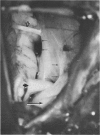Abstract
Operations were performed at four different levels on the fifth nerve of the monkey to determine which procedure offers the best chance of avoiding ocular complications after surgical treatment of trigeminal neuralgia (Figure 18). (1) Section of the ophthalmic branch of N V results in immediate corneal anesthesia. After one week, chromatolysis of the unipolar gasserian ganglion cells subserving the first division occurs and Wallerian degeneration of the corneal nerves of the ipsilateral eye is seen. This is associated with perilimbal round cell invasion of the superficial cornea and subconjunctival area. In addition, iritis develops de novo or becomes worse if it pre-exists. Miosis occurs, but the chemodiagnostic tests of cocaine and adrenalin indicate an intact sympathetic system. The cause for this inflammatory reaction and pupillary change is unexplained by this study. The intraocular pressure is slightly lower on the side of the section than in the normal fellow control eye after surgery, but the difference is not statistically significant. (2) Section of the posterior sensory root of N V in the middle cranial fossa at a point between the gasserian glanglion and the tentorium results in similar ocular changes as is seen after interrupting the ophthalmic division alone. Wallerian degeneration of the corneal nerves, however, is not seen after seven, twelve or twenty-one days. (3) Transtentorial section of the trigeminal posterior sensory root performed in the middle cranial fossa, results in immediate corneal anesthesia. The gasserian ganglion cells, however, remain healthy and there is no perilimbal round cell invasion of the superficial cornea or subconjunctival tissue. Miosis occurs but the chemodiagnostic tests of cocaine and adrenalin indicate an intact sympathetic system. The intraocular pressure is only slightly lower on the side of section than in the control eye, but the difference is not statistically significant. (4) Suboccipital rhizotomy of the posterior sensory root of NV at the pons results in immediate corneal anesthesia. The gasserian ganglion cells remain healthy and there is no perilimbal round cell invasion of the superficial cornea or subconjunctival tissue. Miosis occurs in most animals (2 of 3) and is associated with an intact sympathetic system as indicated by the chemodiagnostic tests of cocaine and adrenalin. Intraocular pressure is very slightly lower on the side of section than in the control eye, but the difference is not statistically significant. (5) Thinning of the corneal epithelium occurs in an anesthetic eye regardless of the location of the section of N V and is not adversely affected by tarsorrhaphy. The corneal stroma, however, remains unchanged. (6) The experimental data demonstrate that to decrease ocular complications, operations on the trigeminal nerve should be performed on the caudal end of the sensory root as far from the gasserian ganglion as is techanically feasible.
Full text
PDF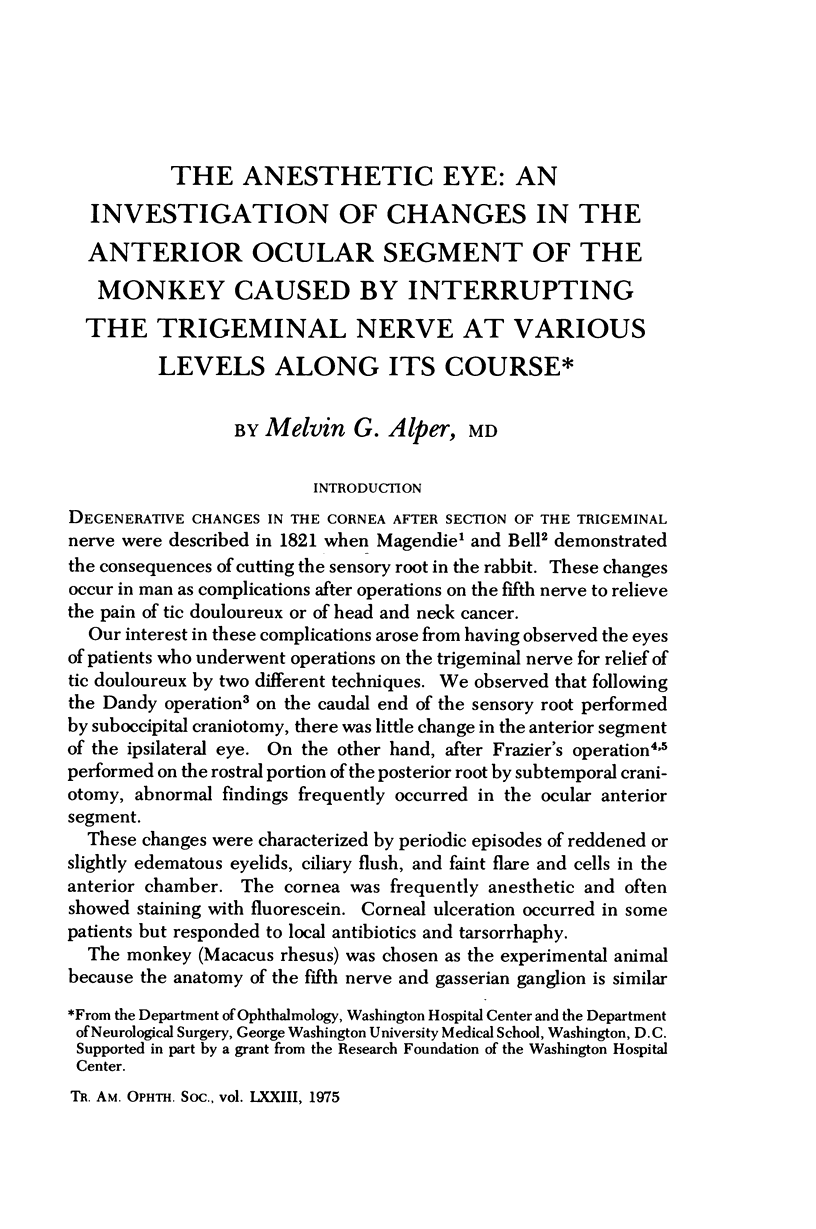

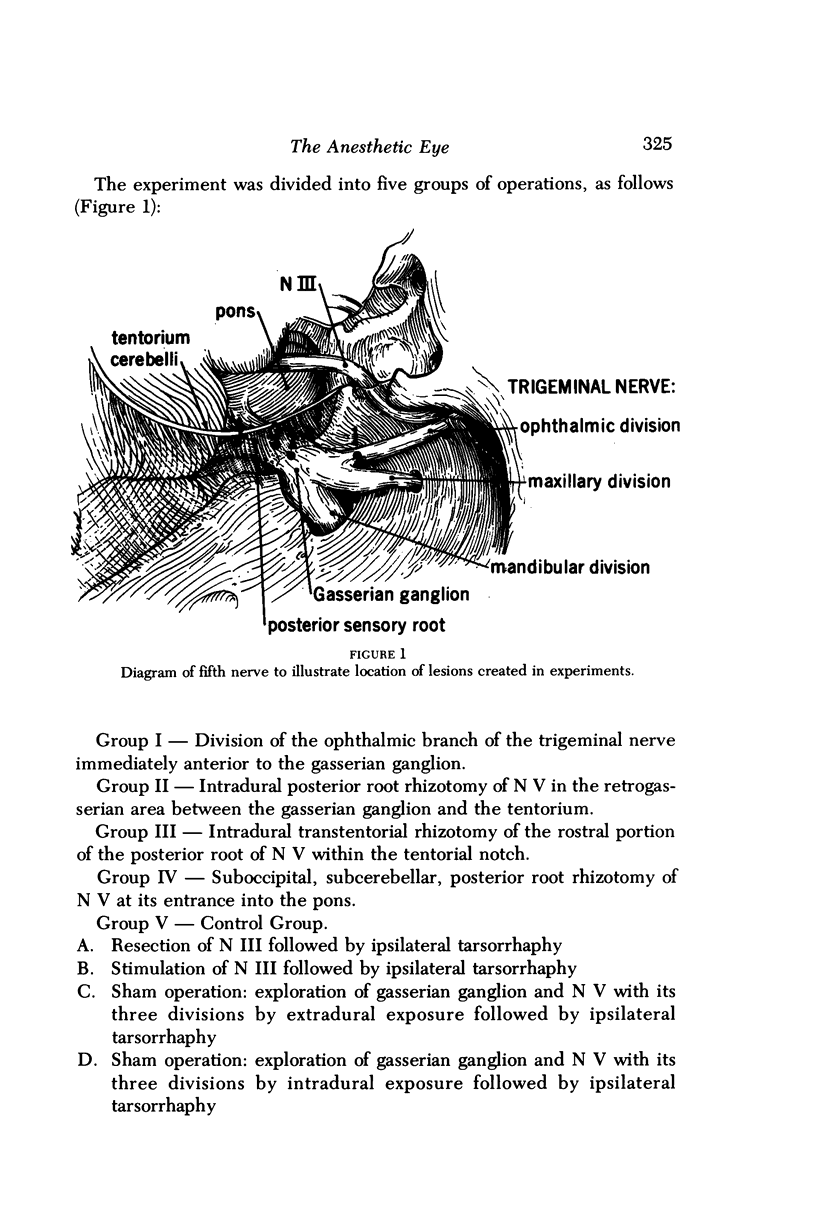

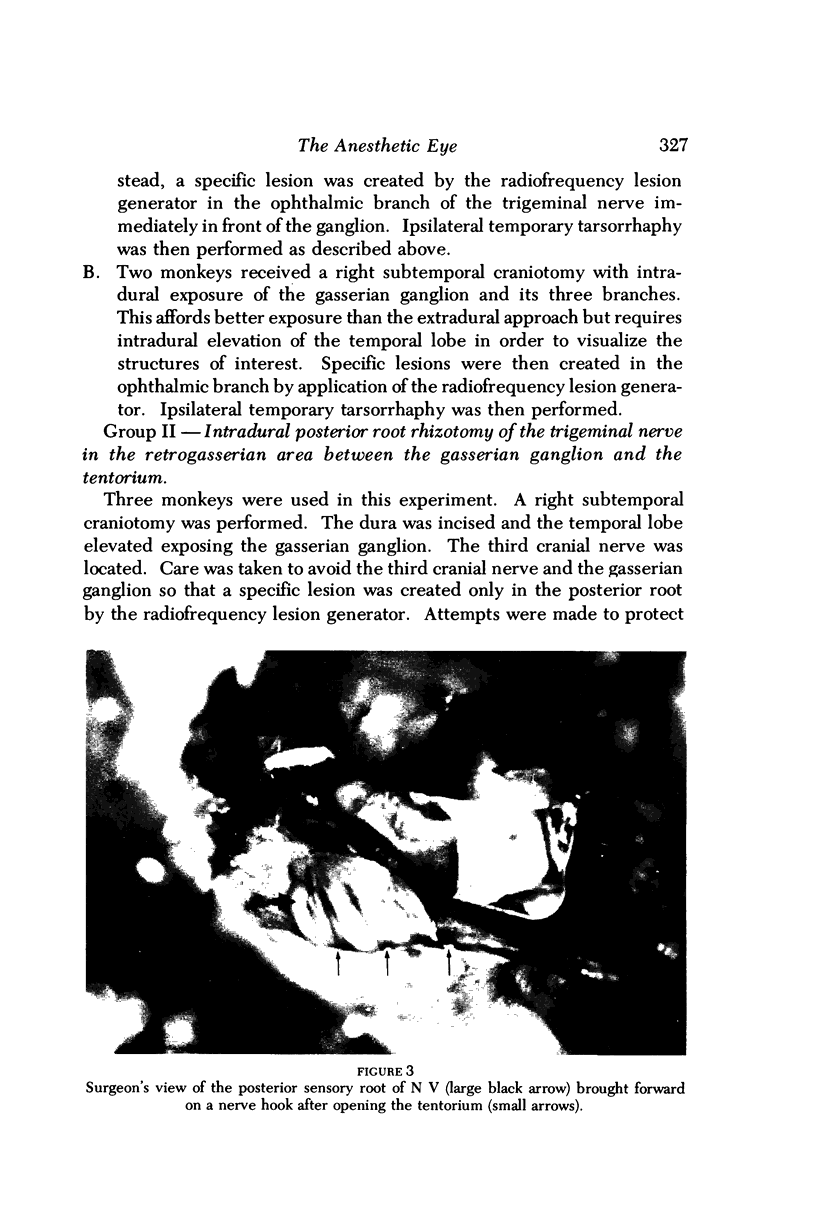
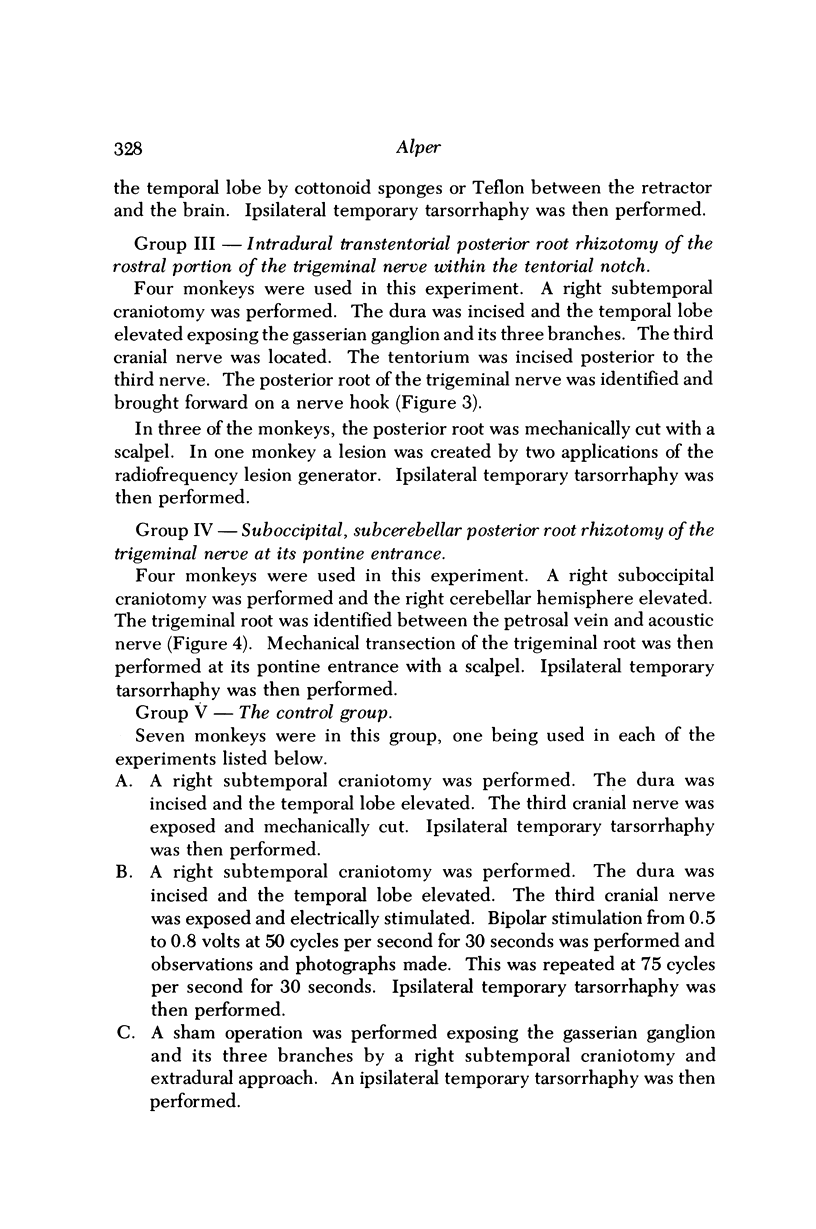
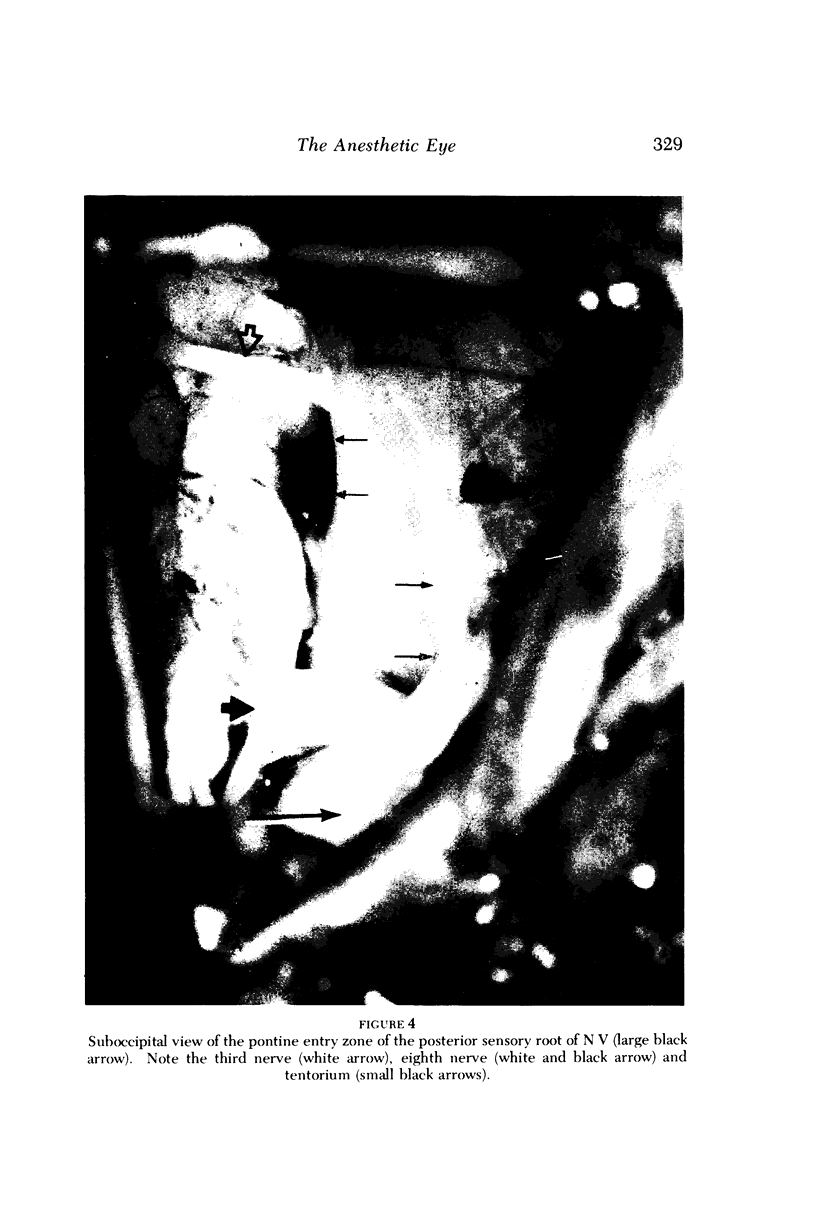
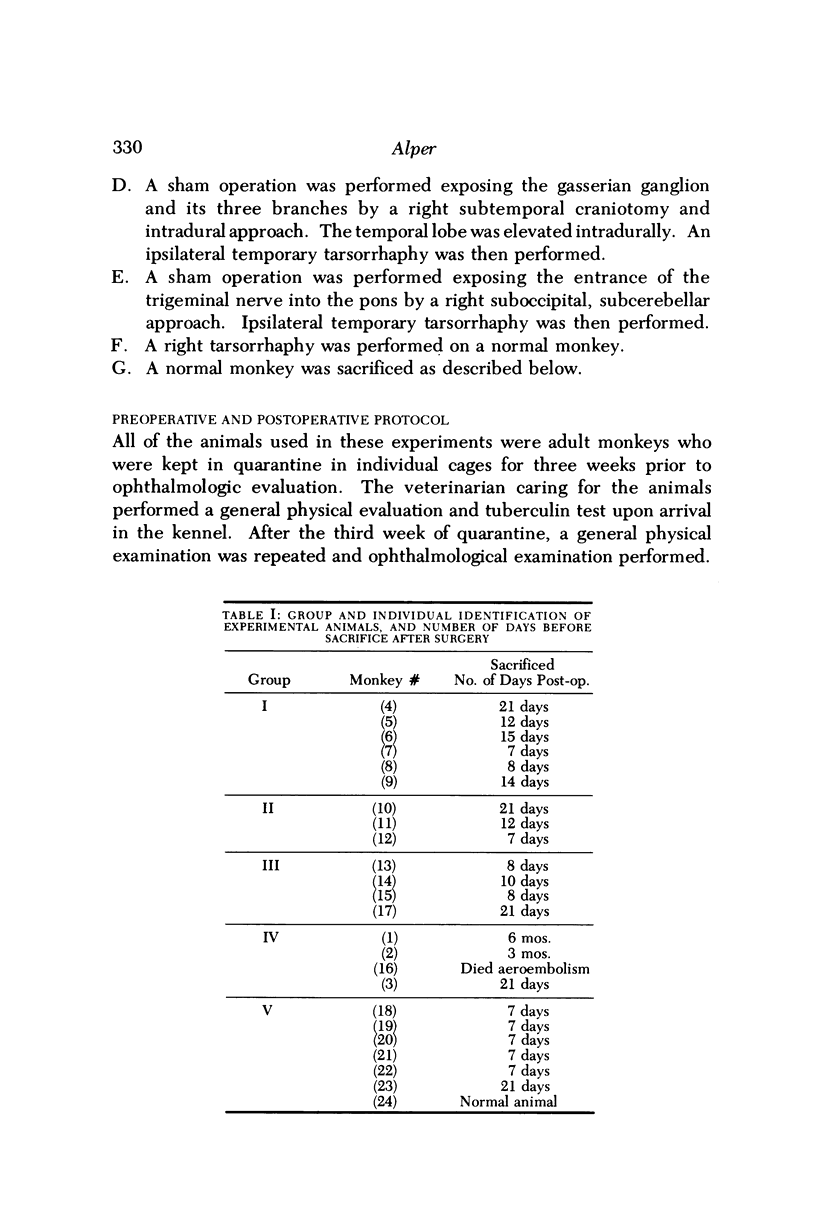
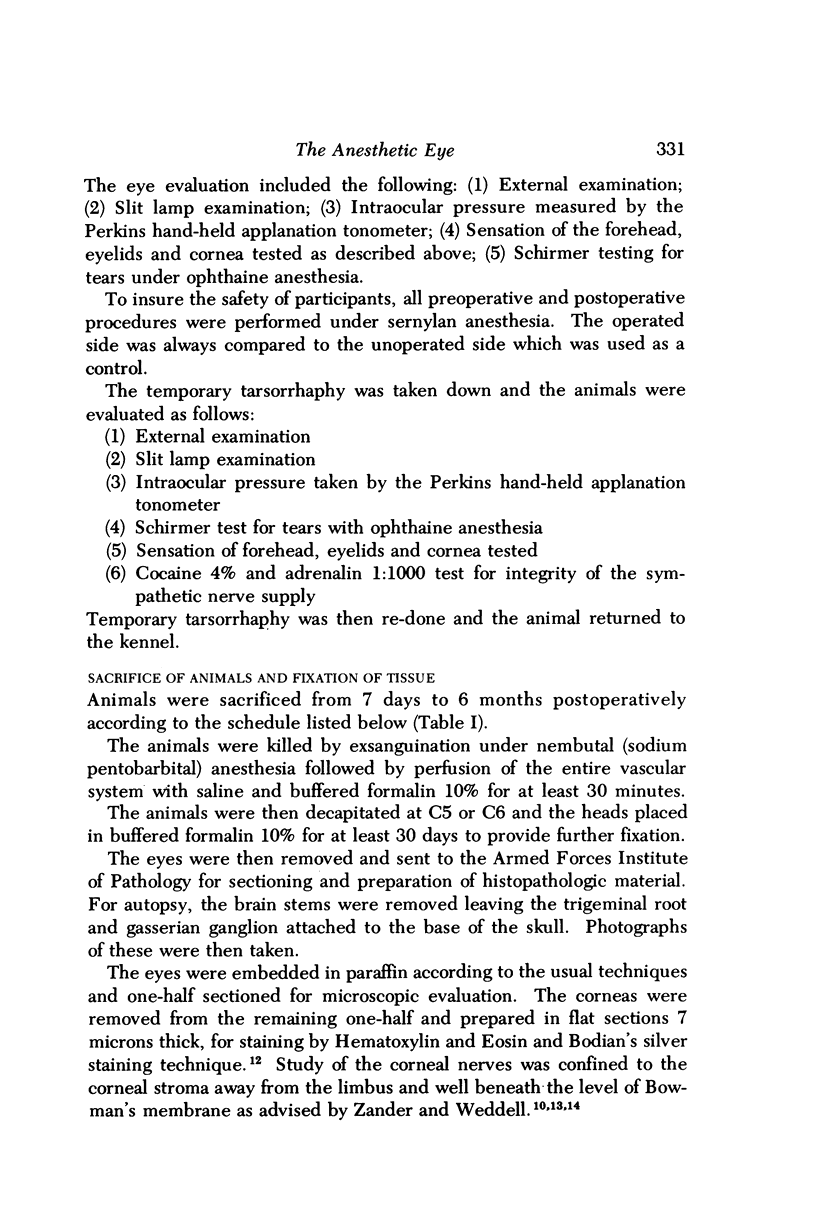
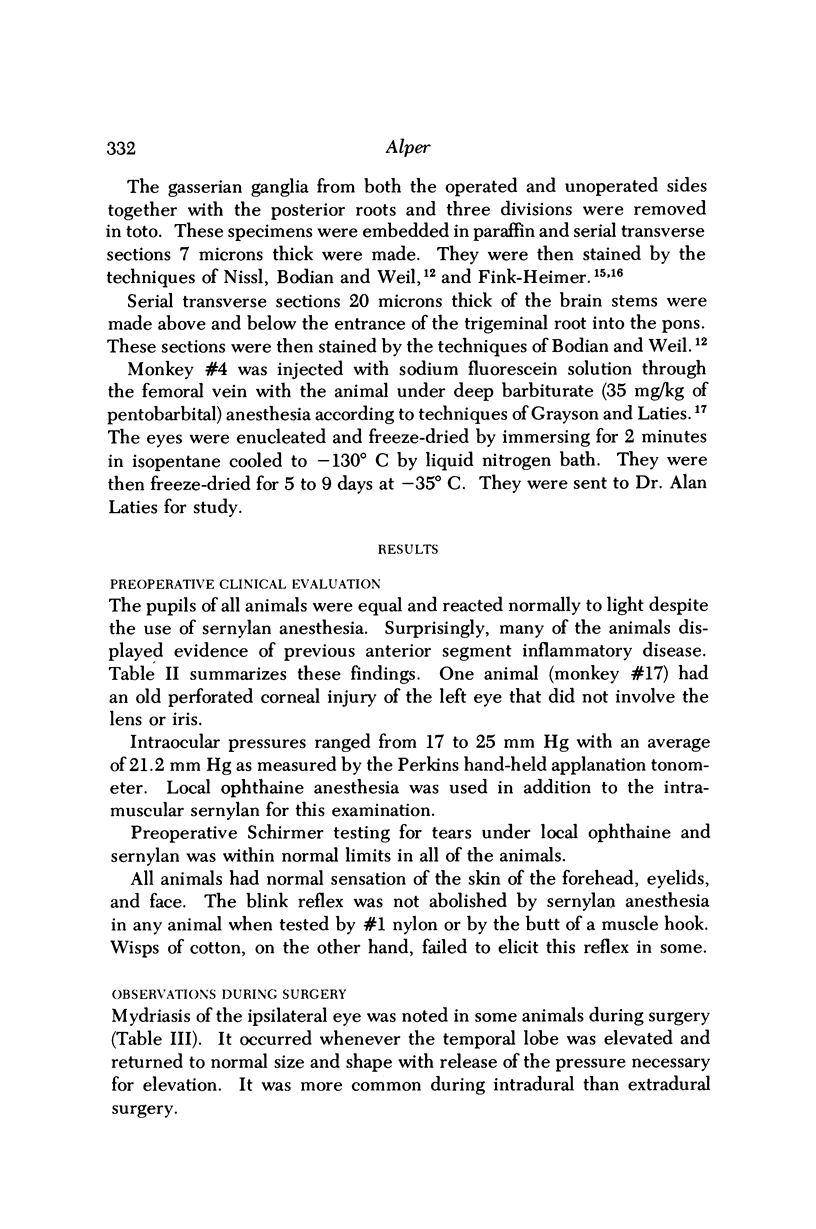
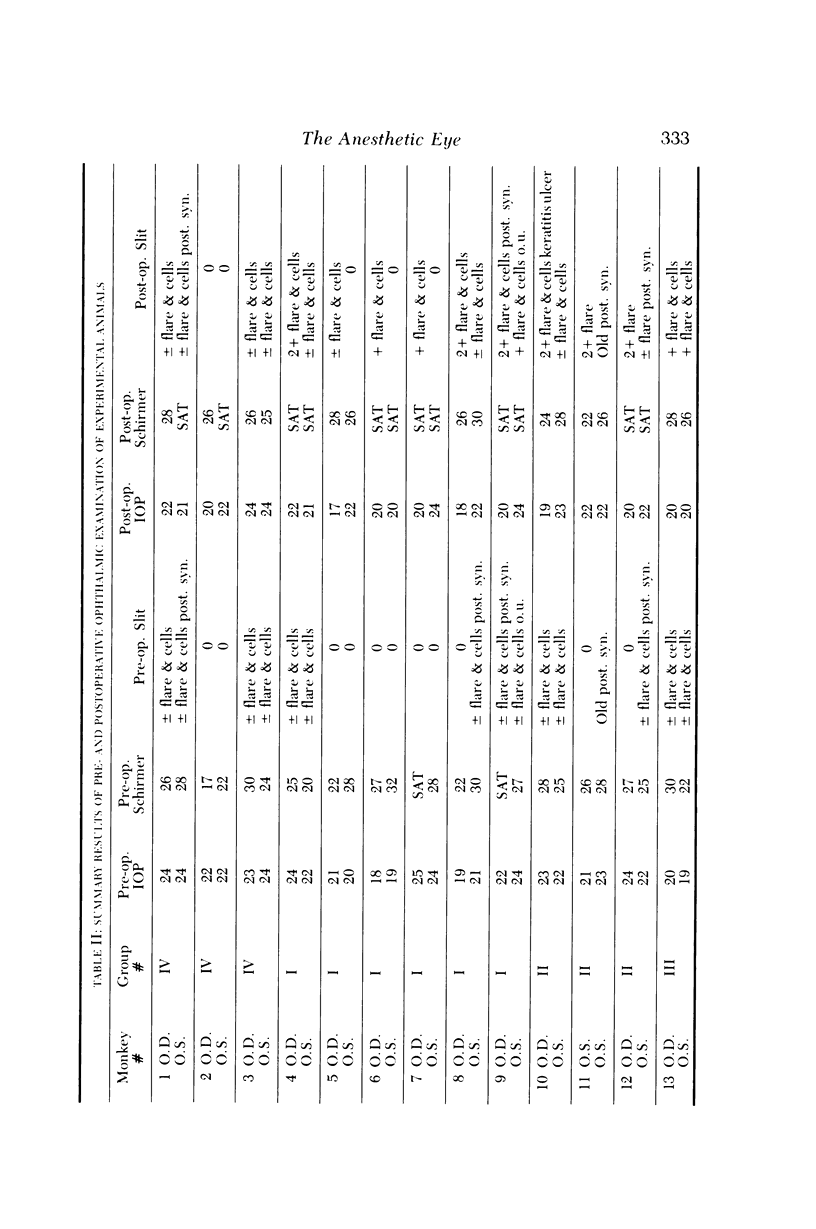
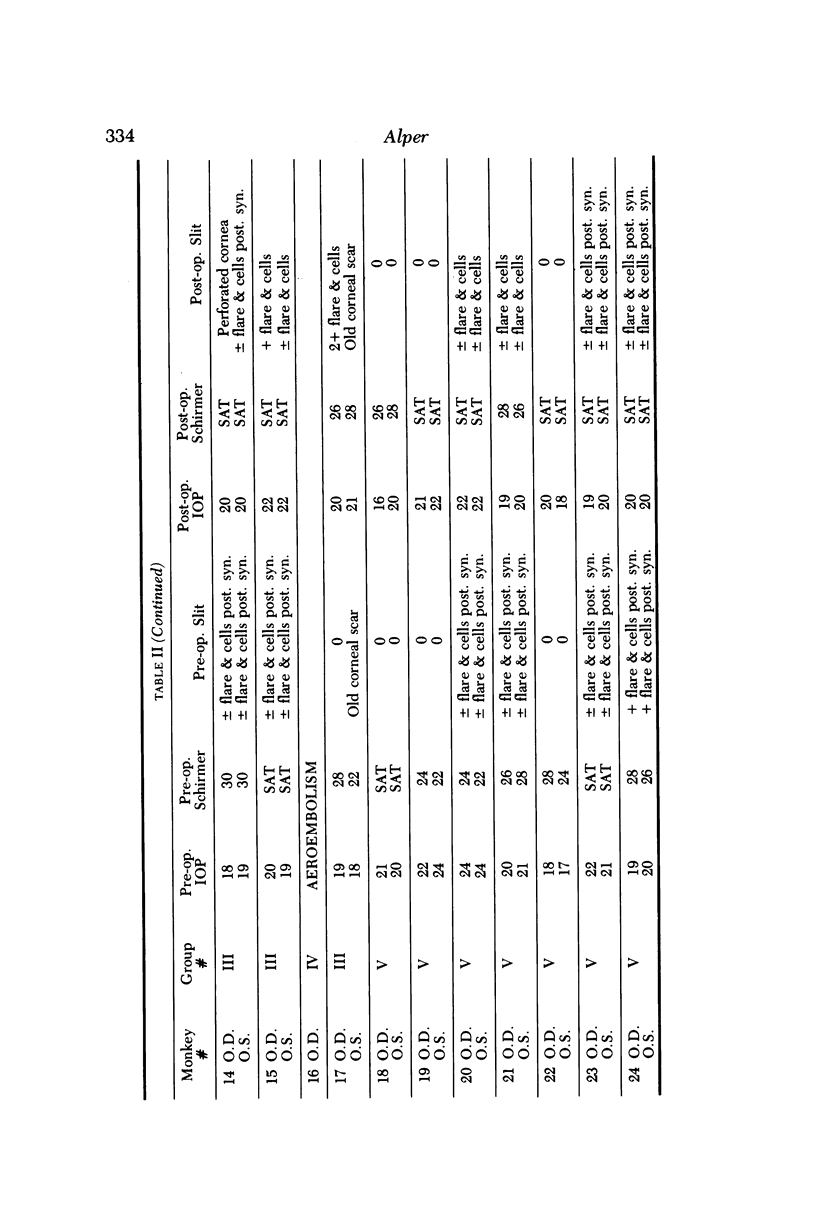

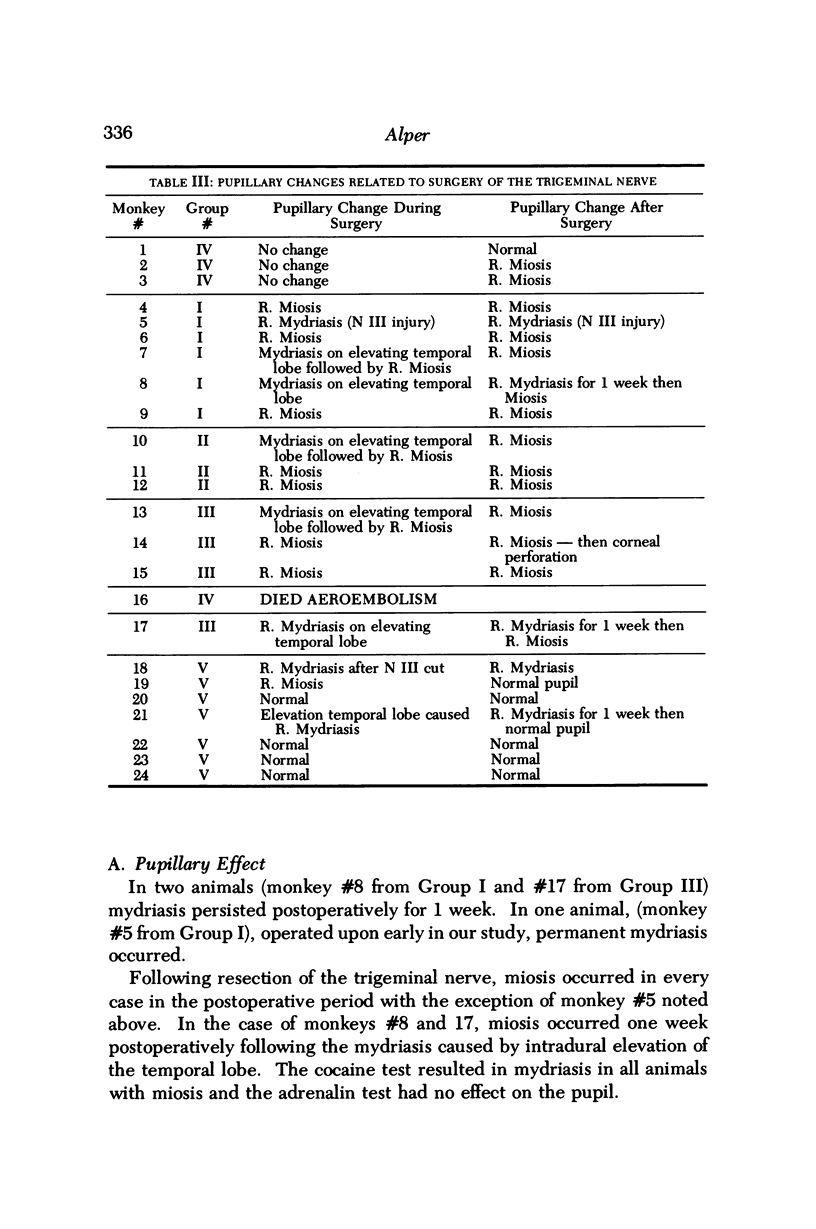
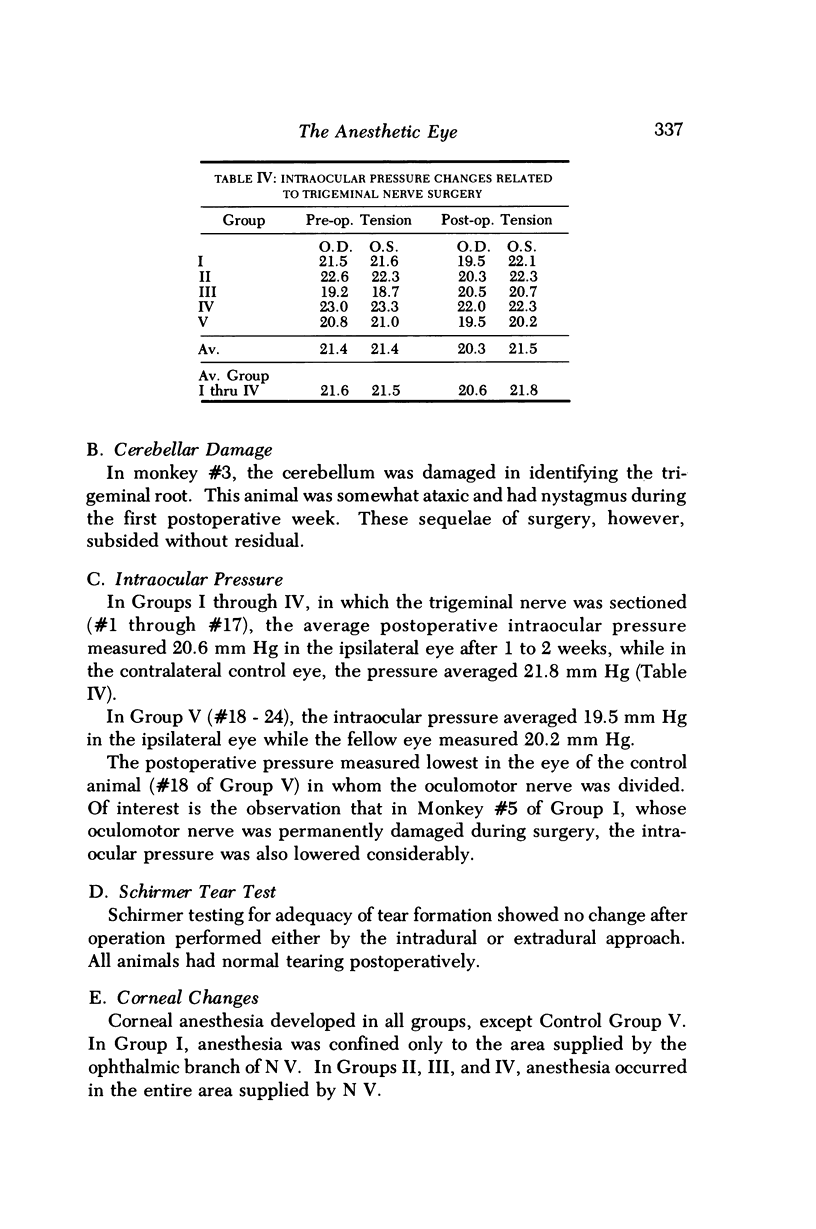
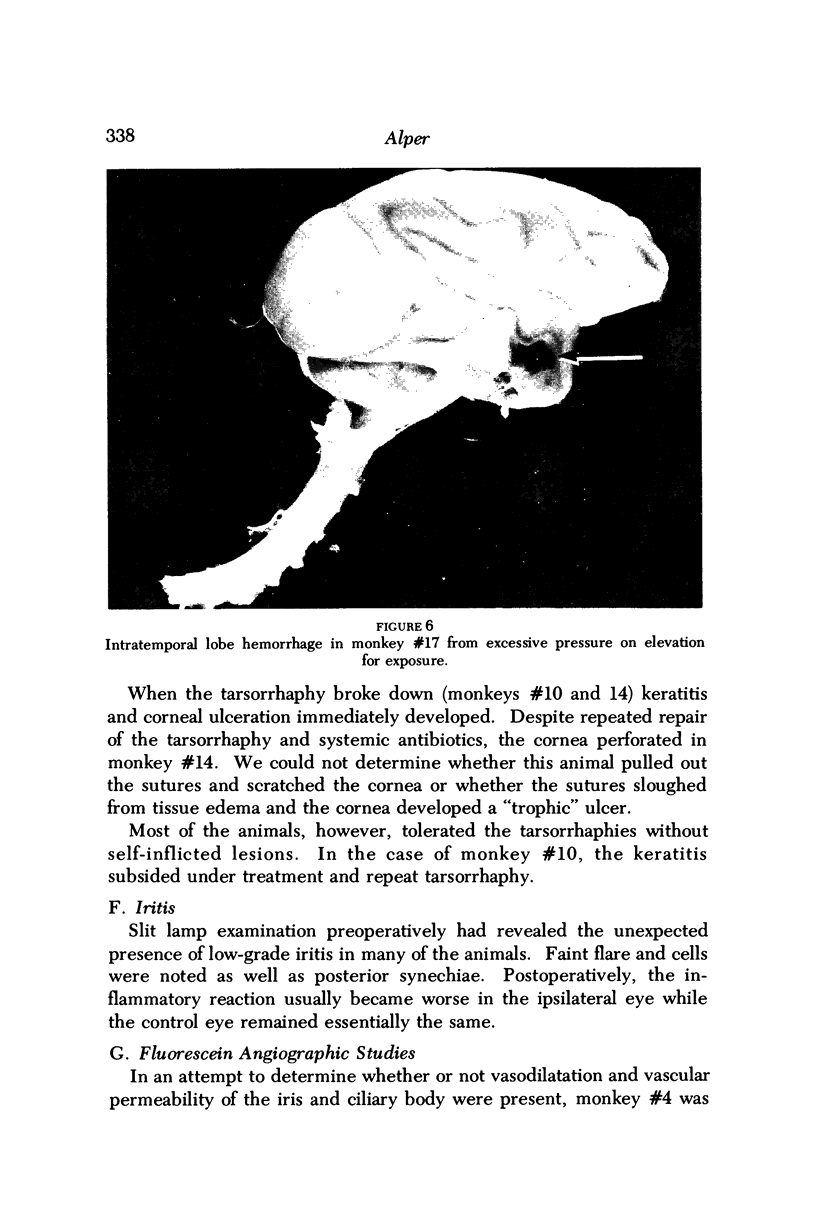
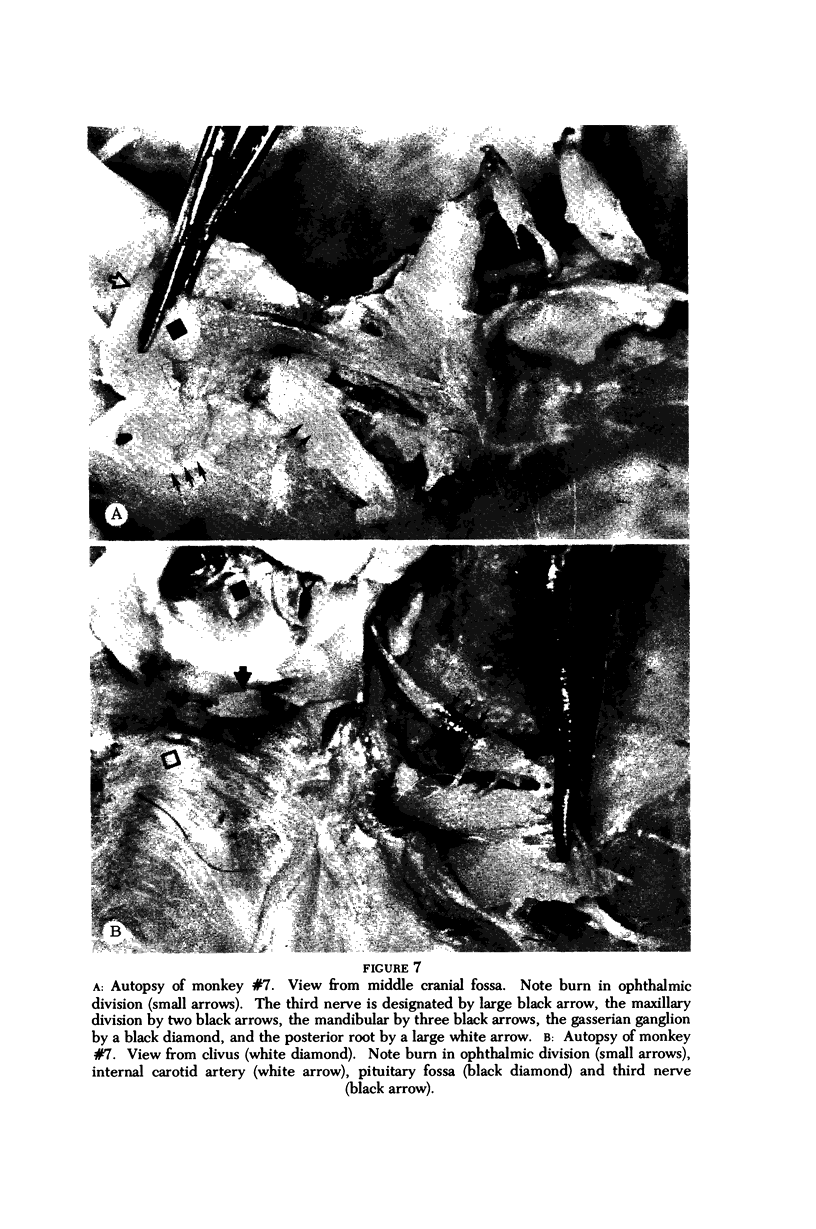

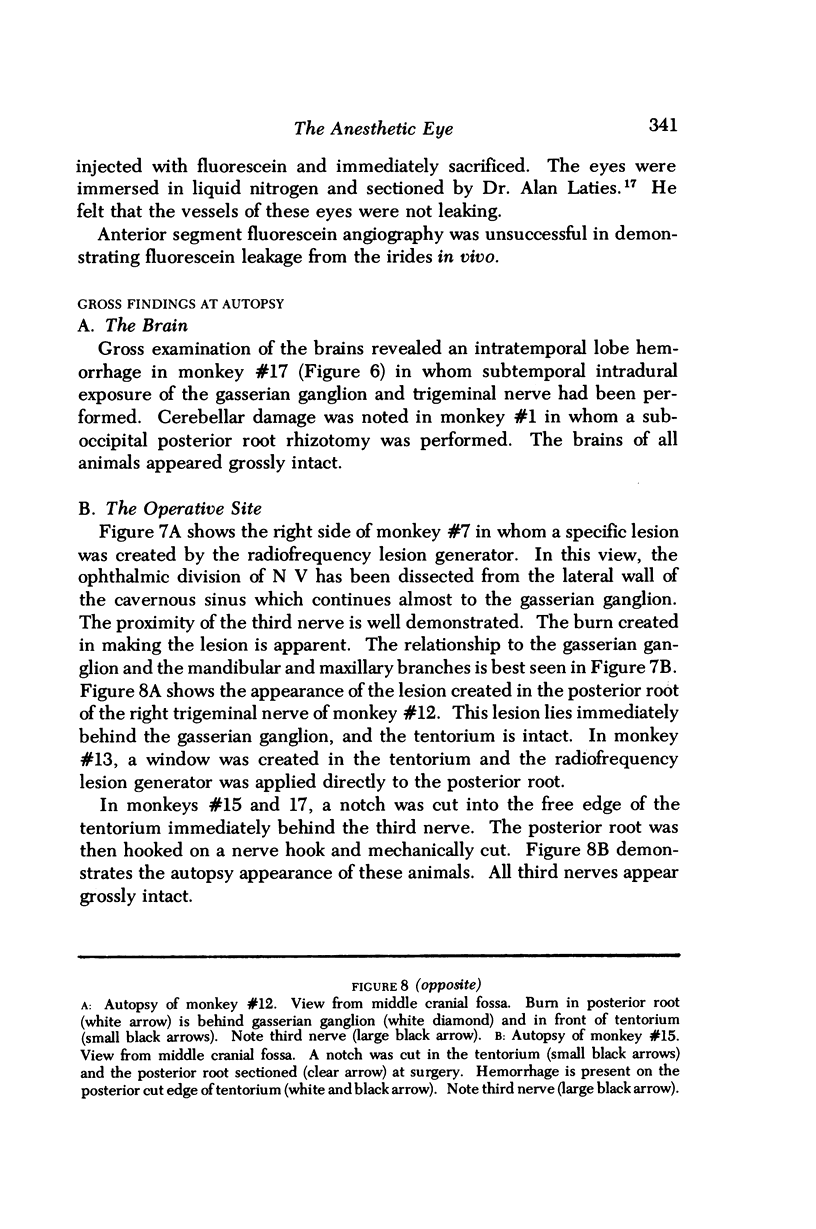
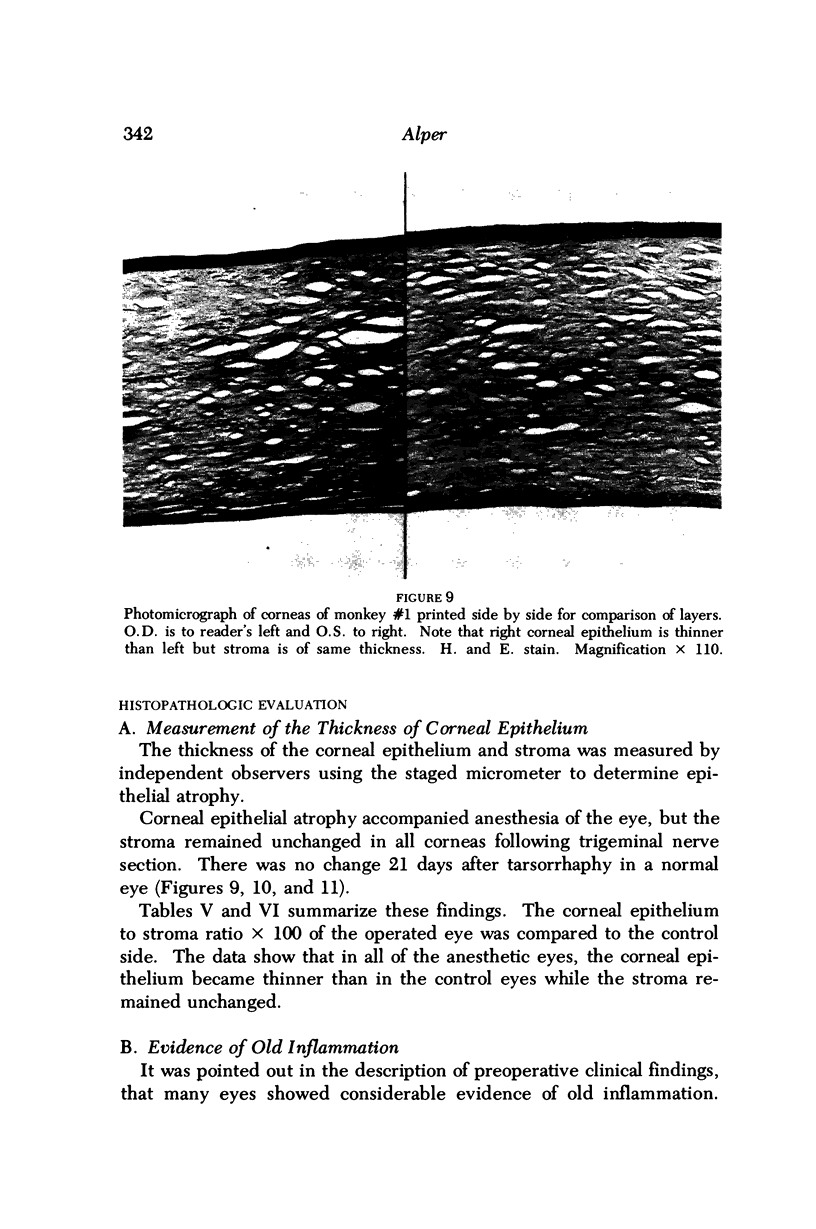
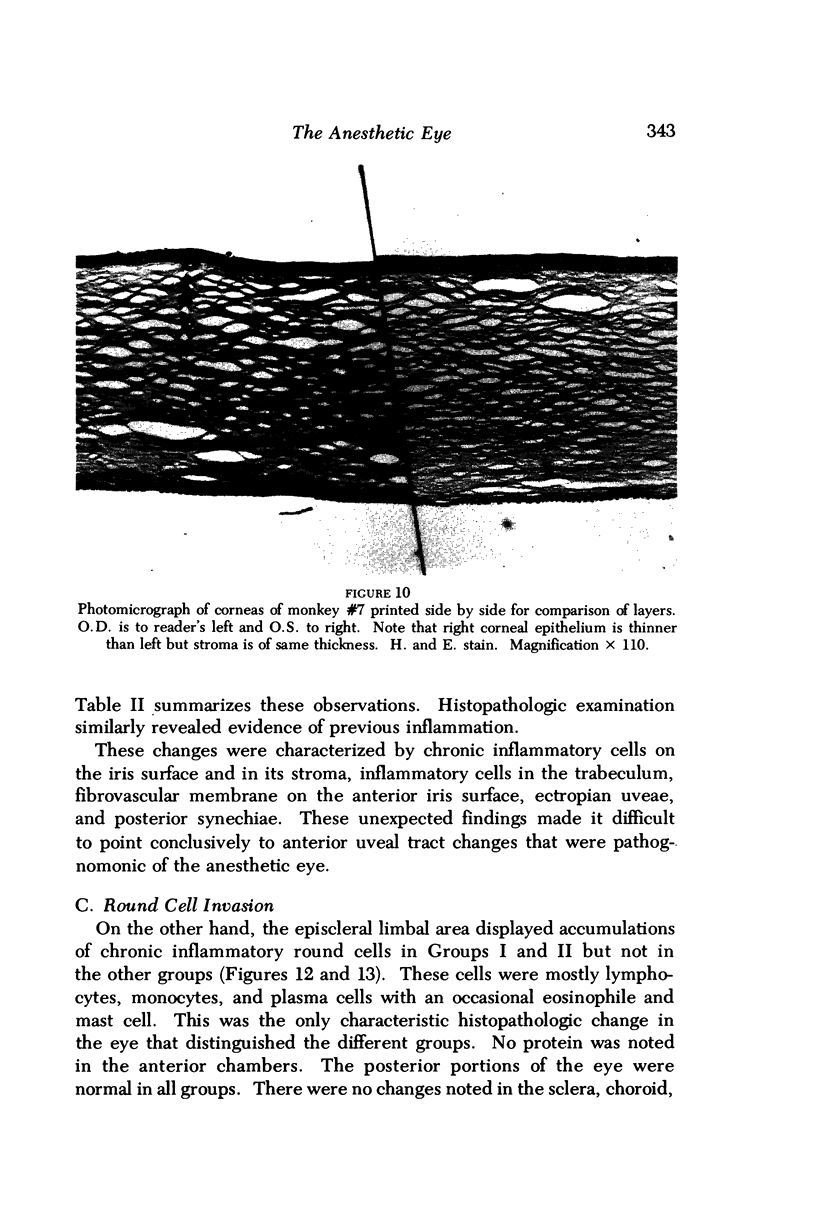
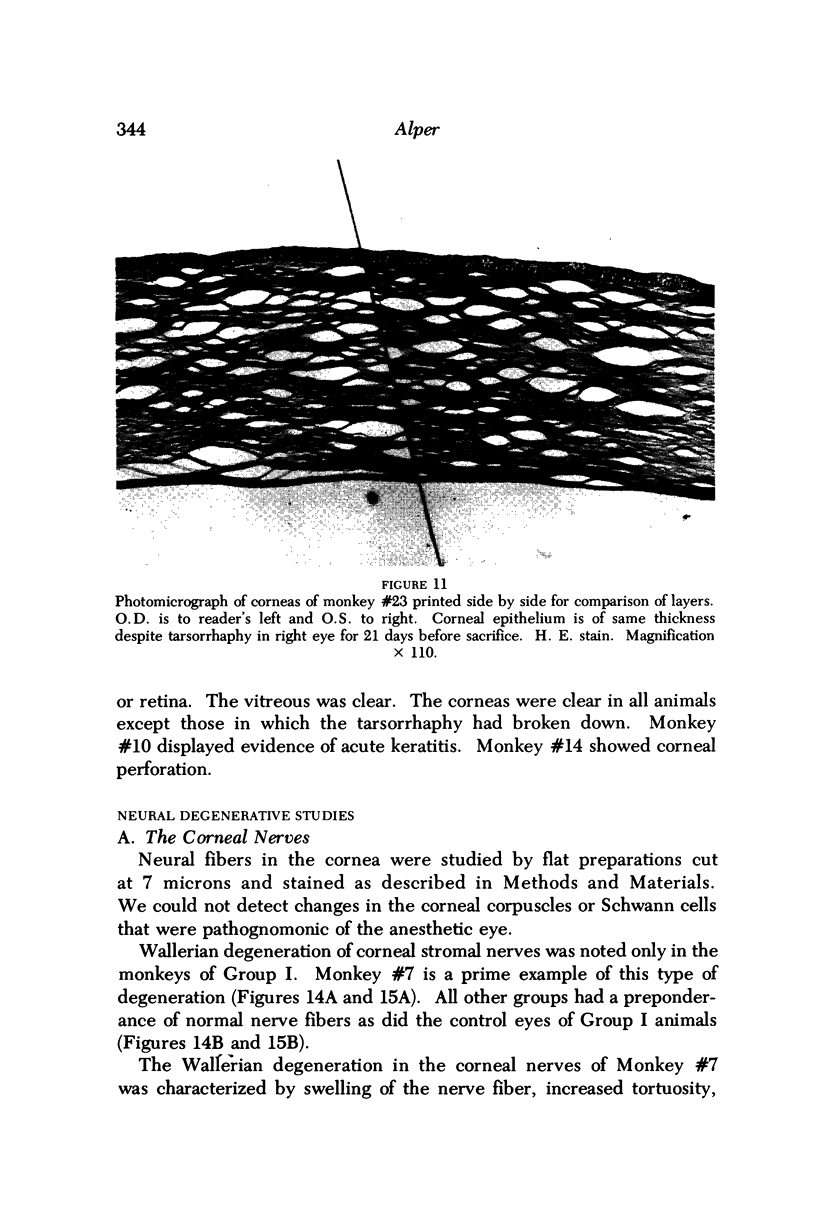
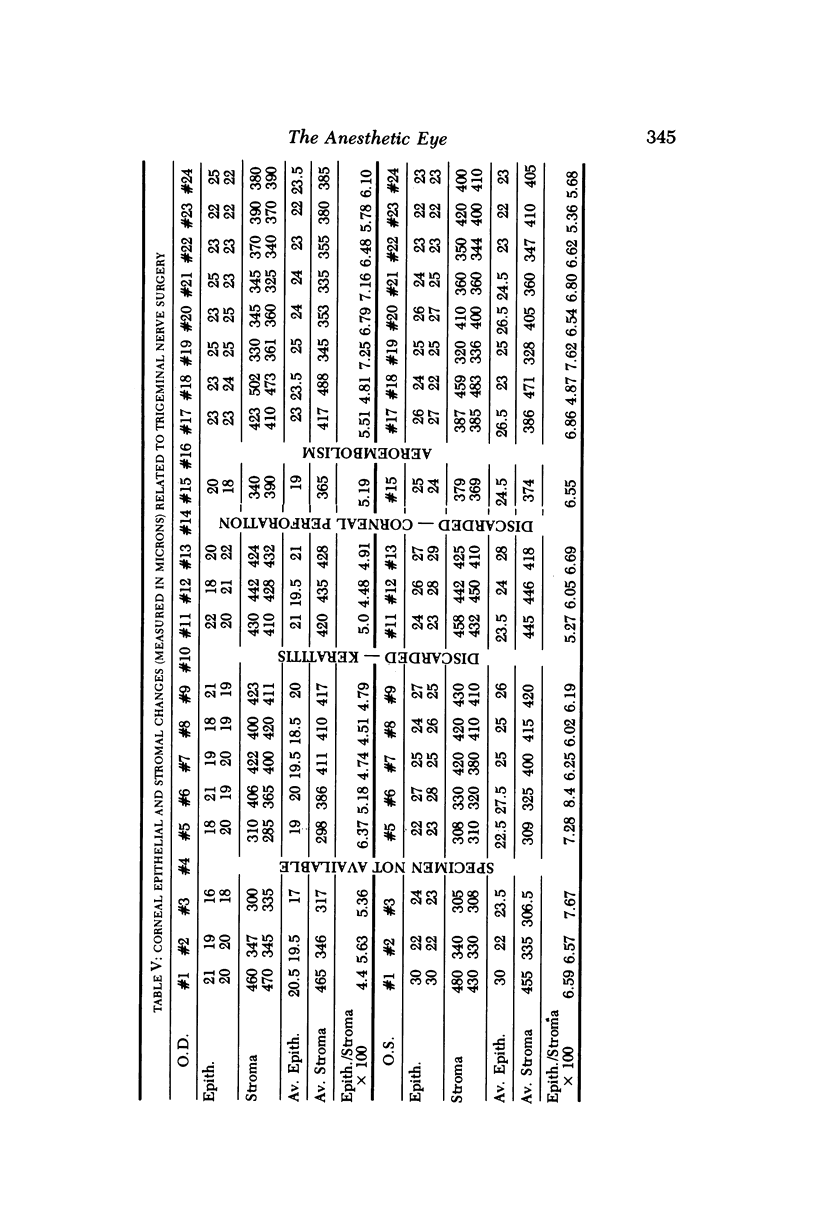

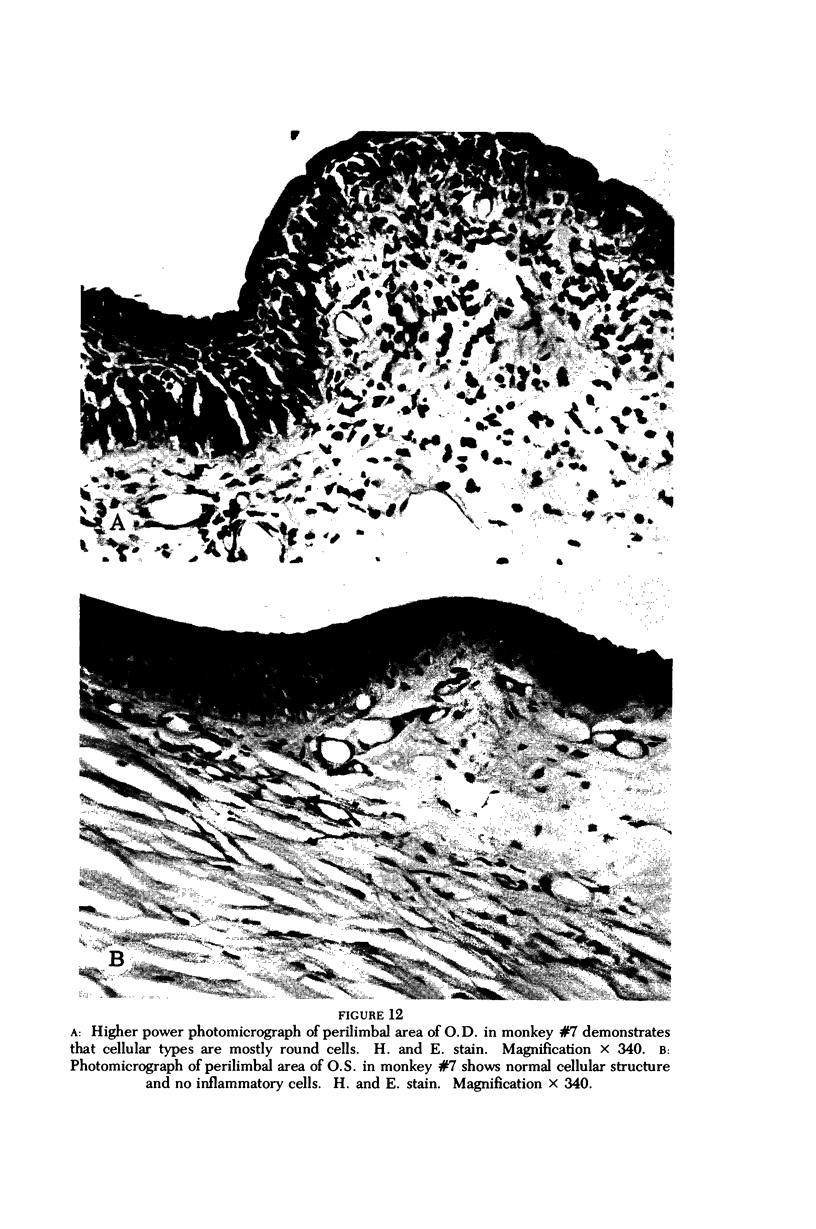
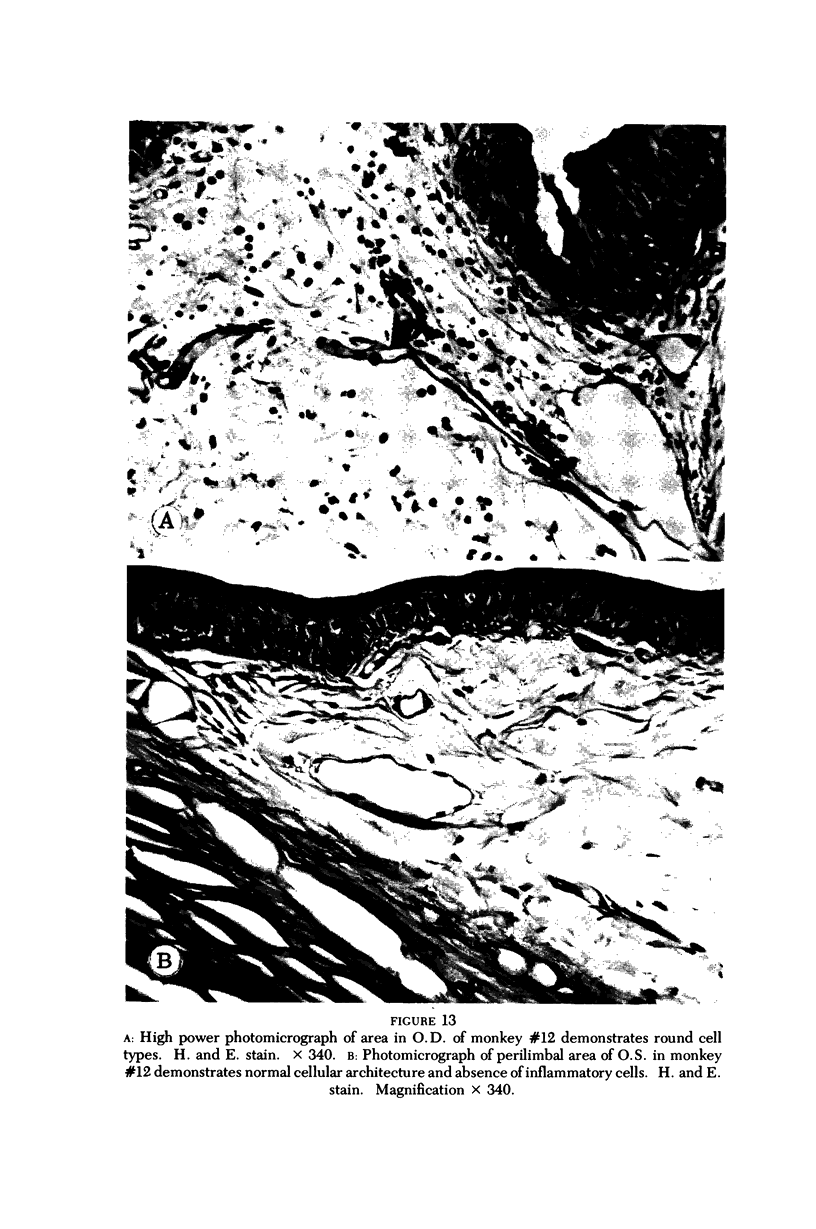
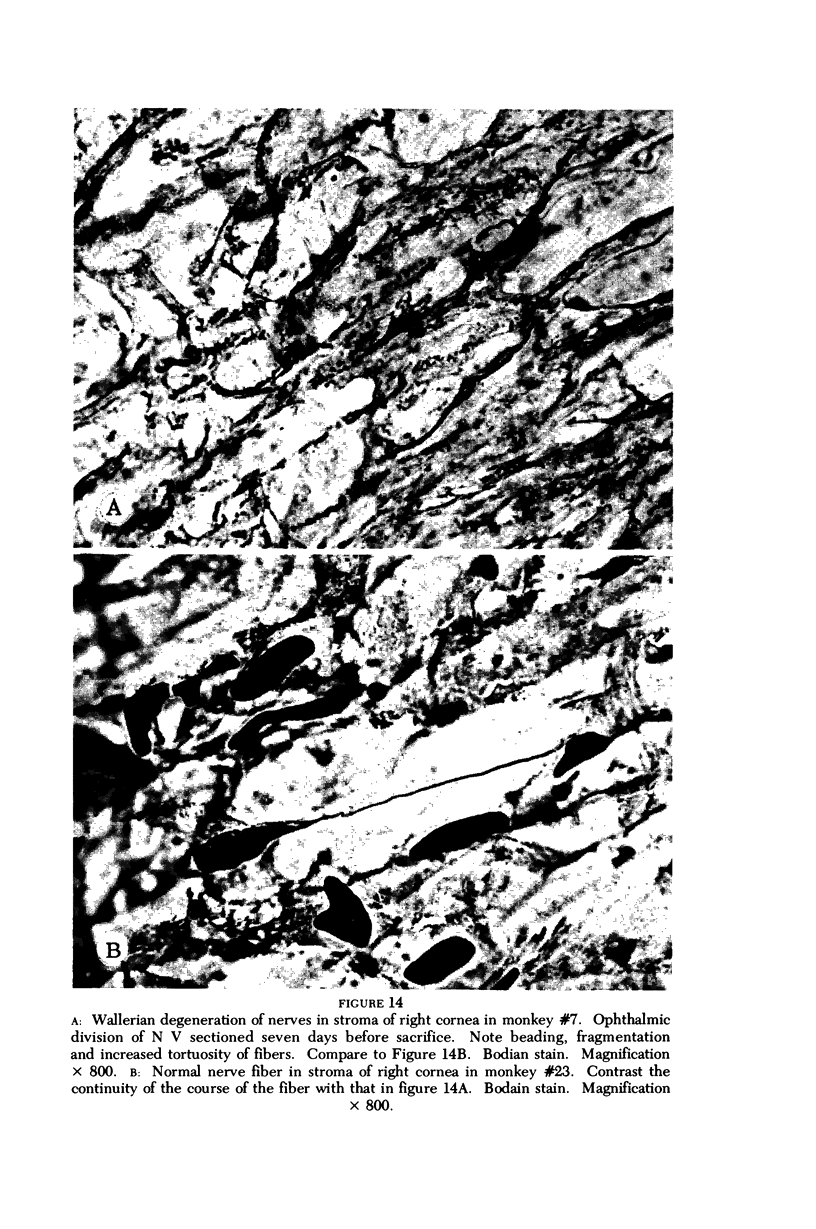
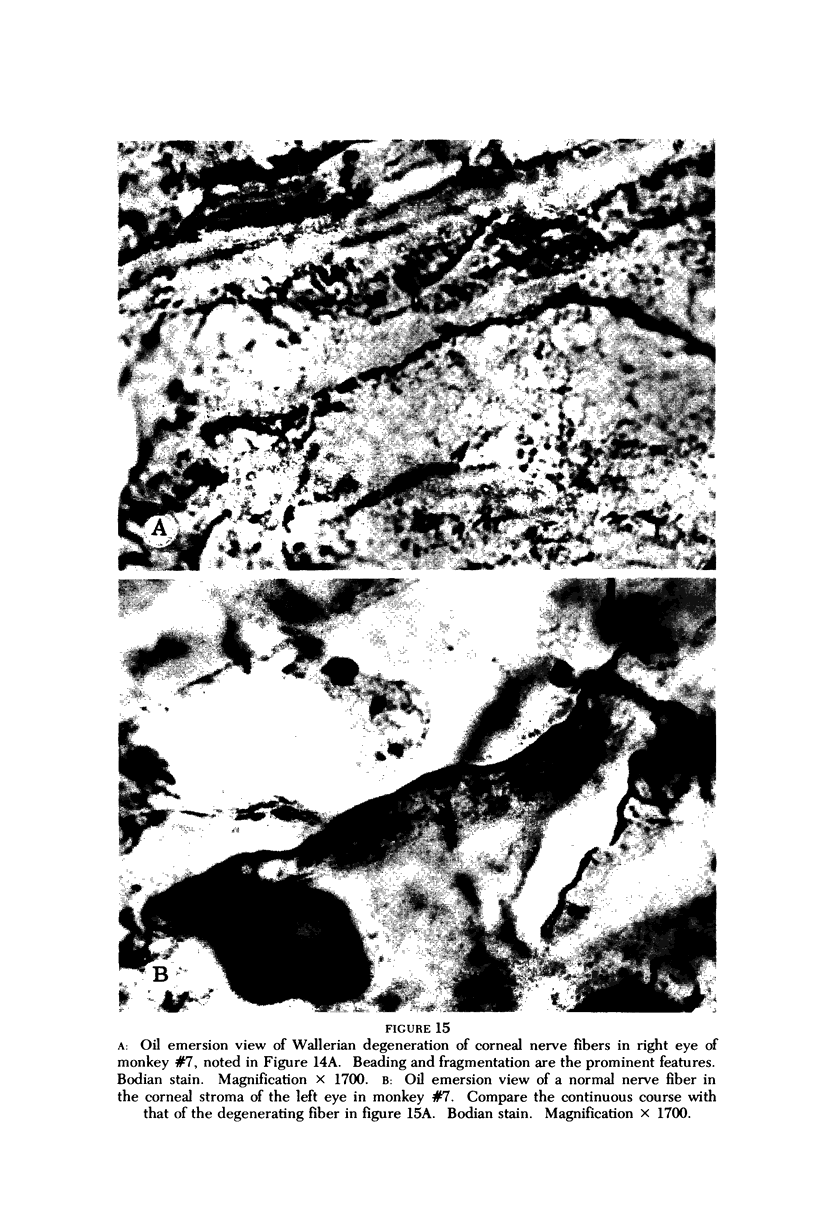
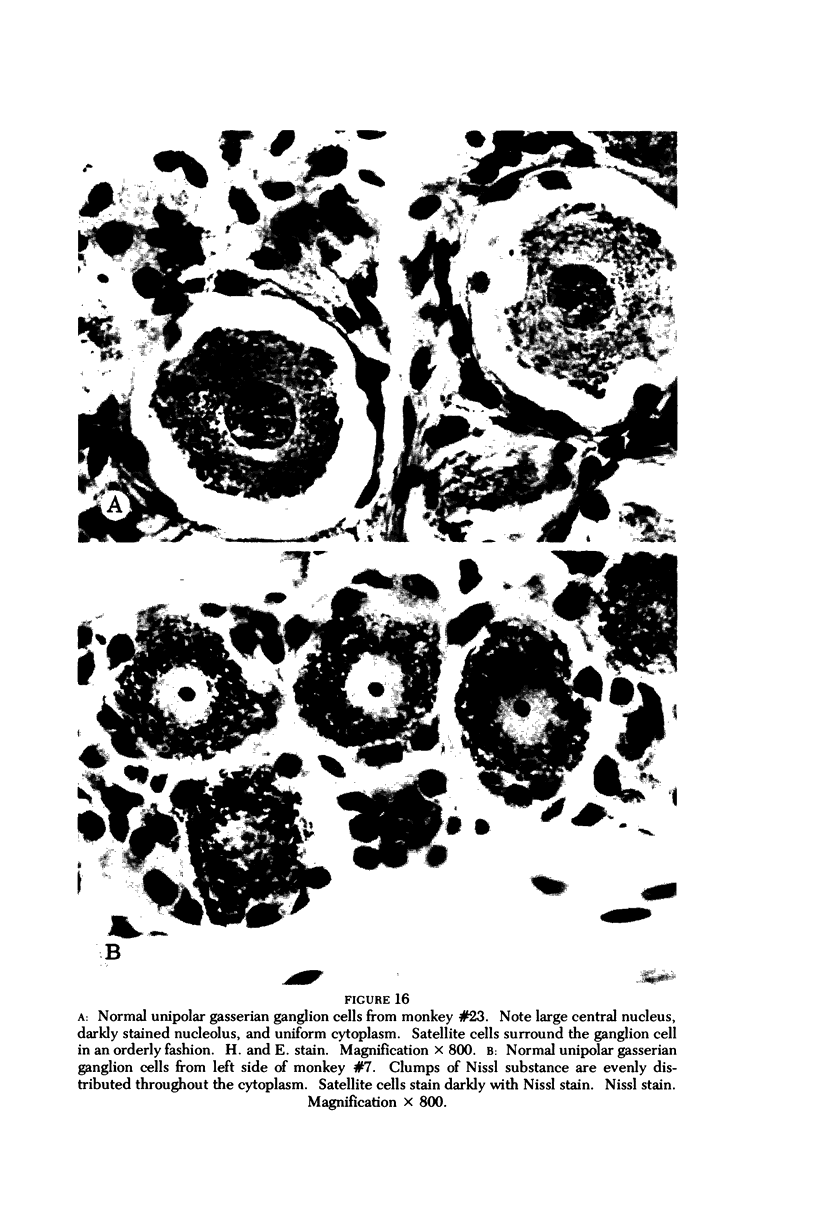
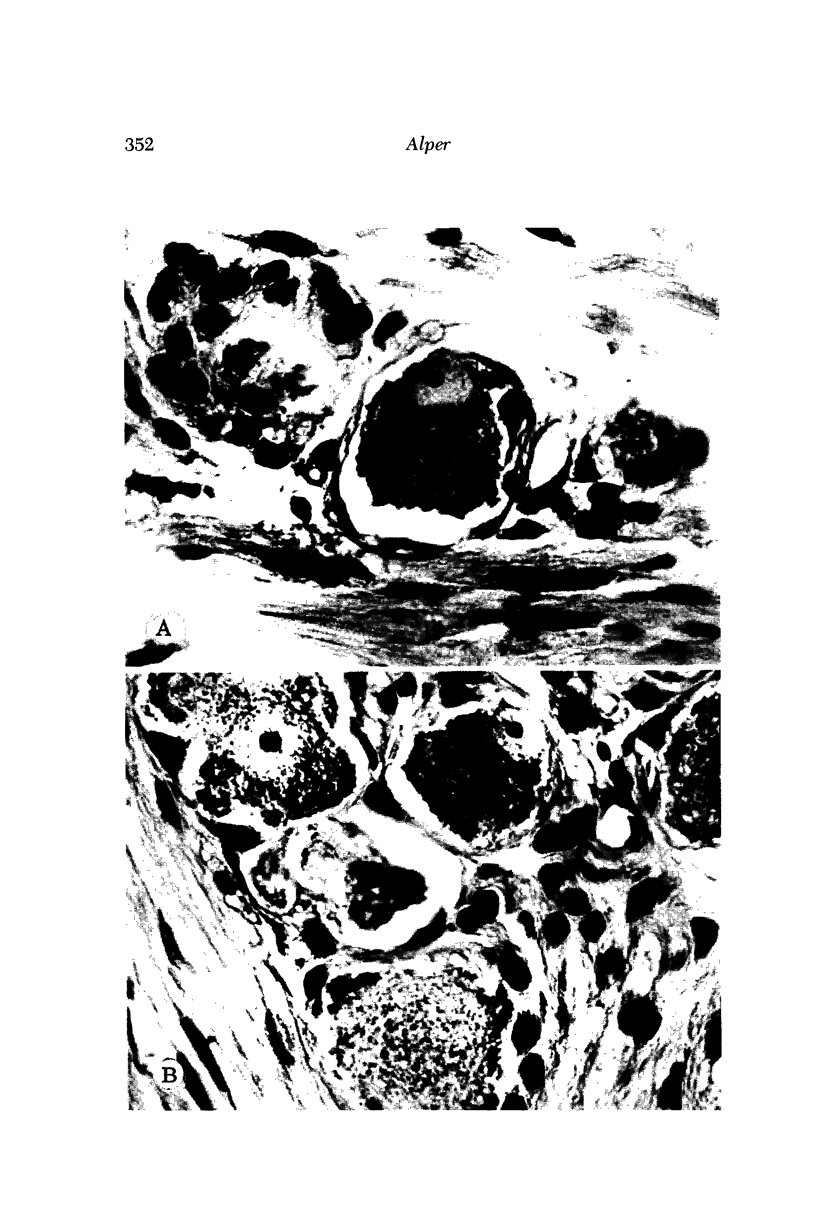
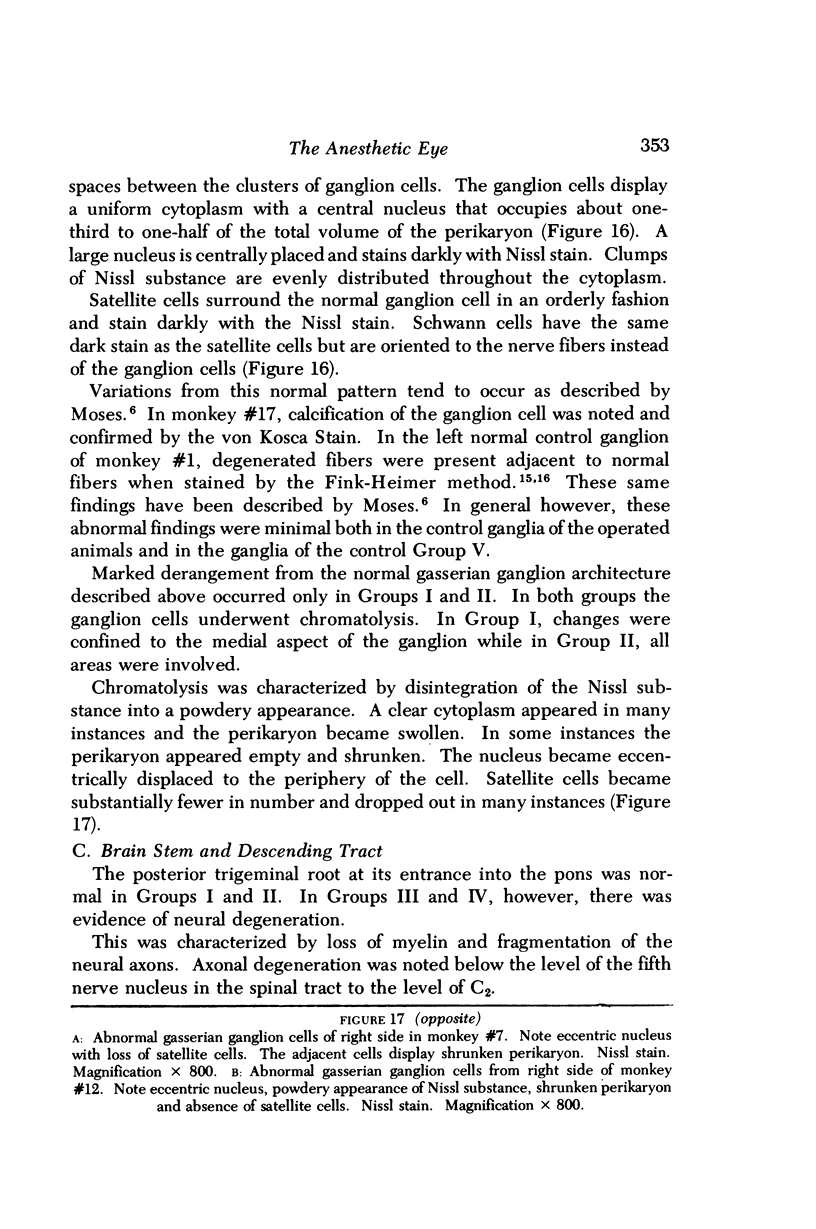
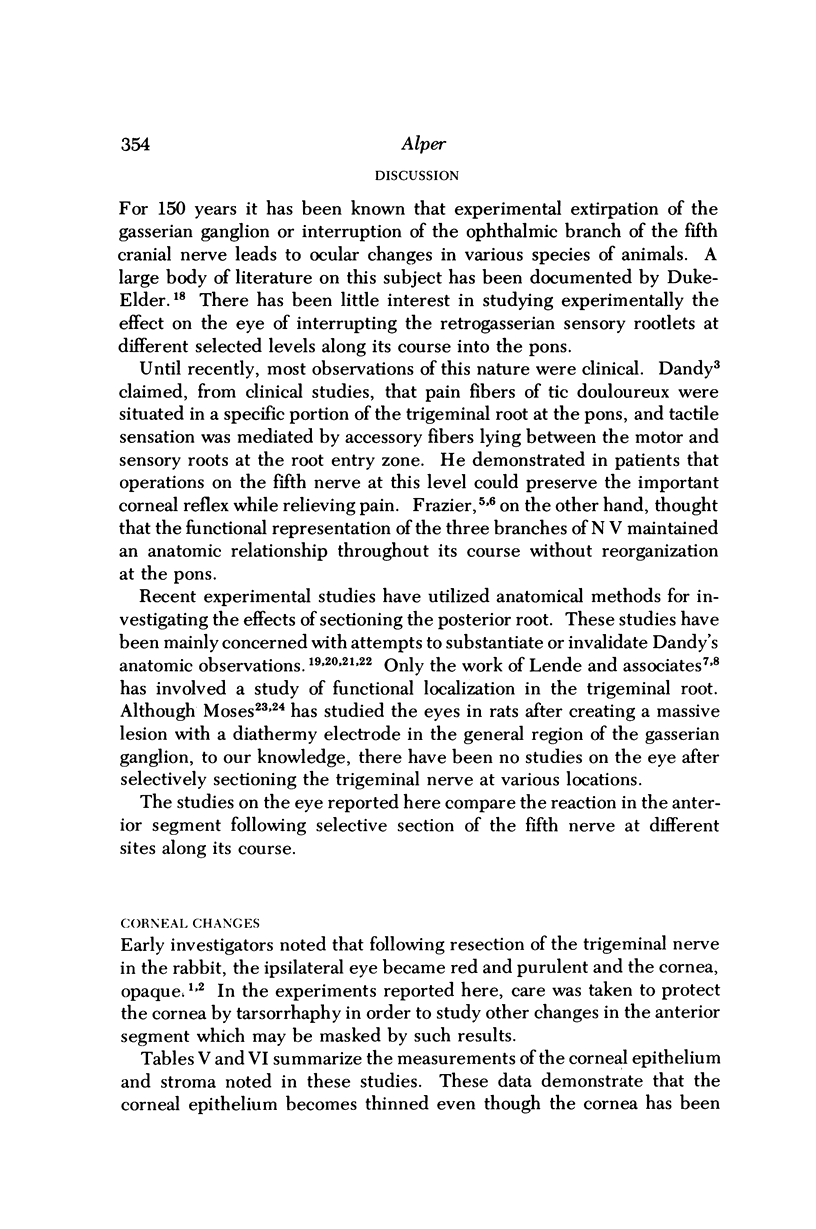
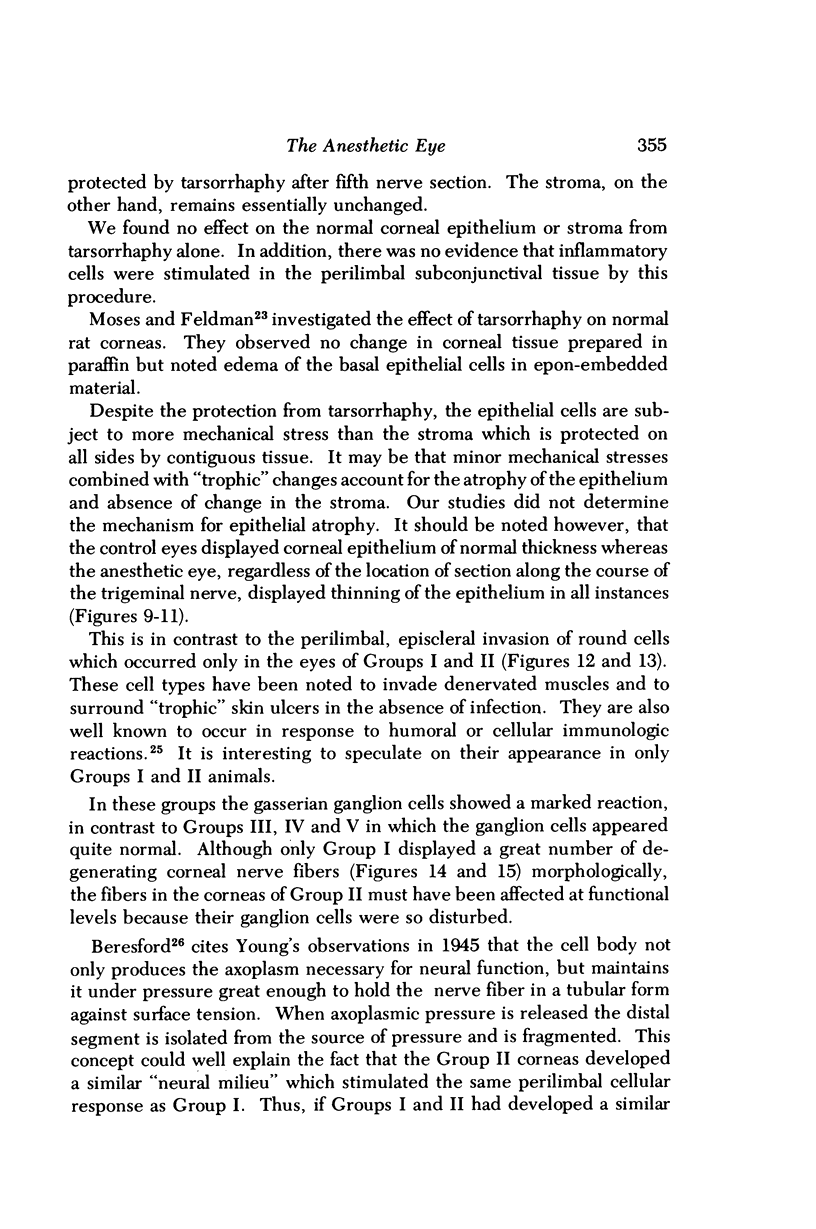
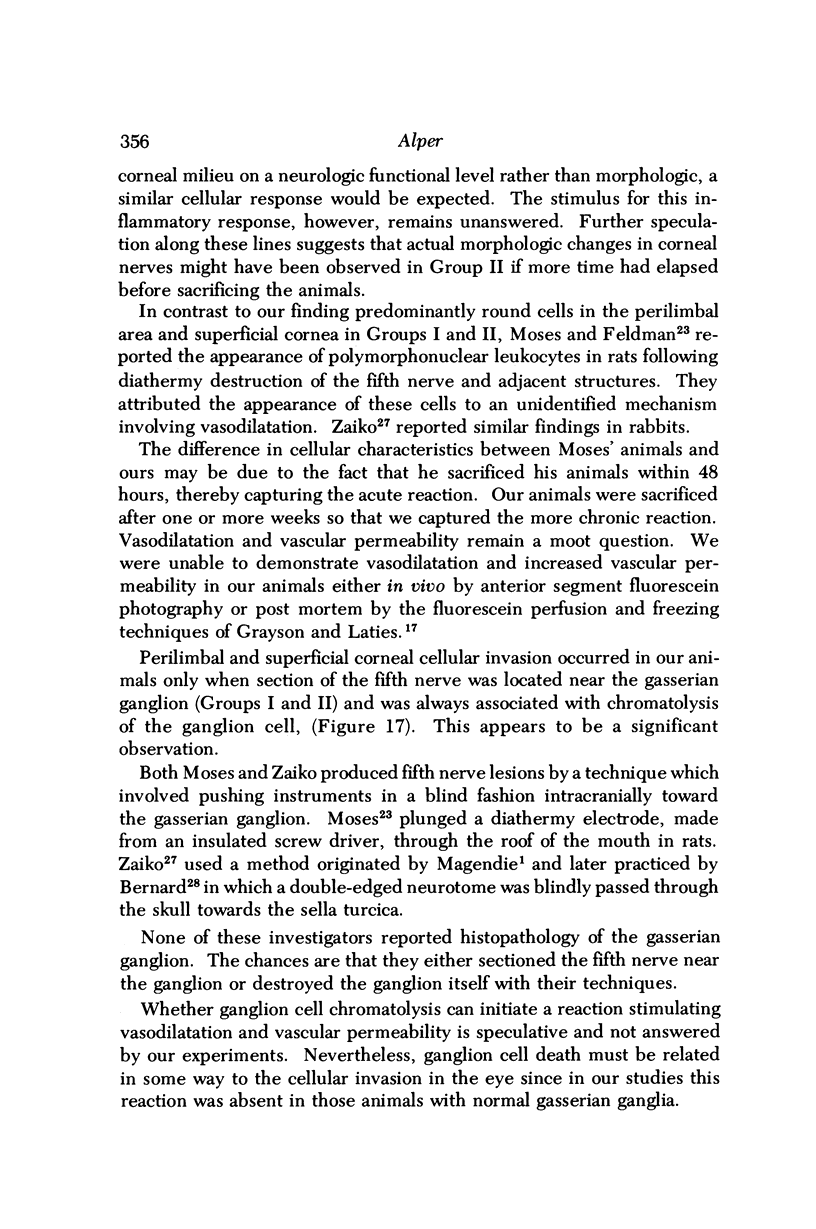
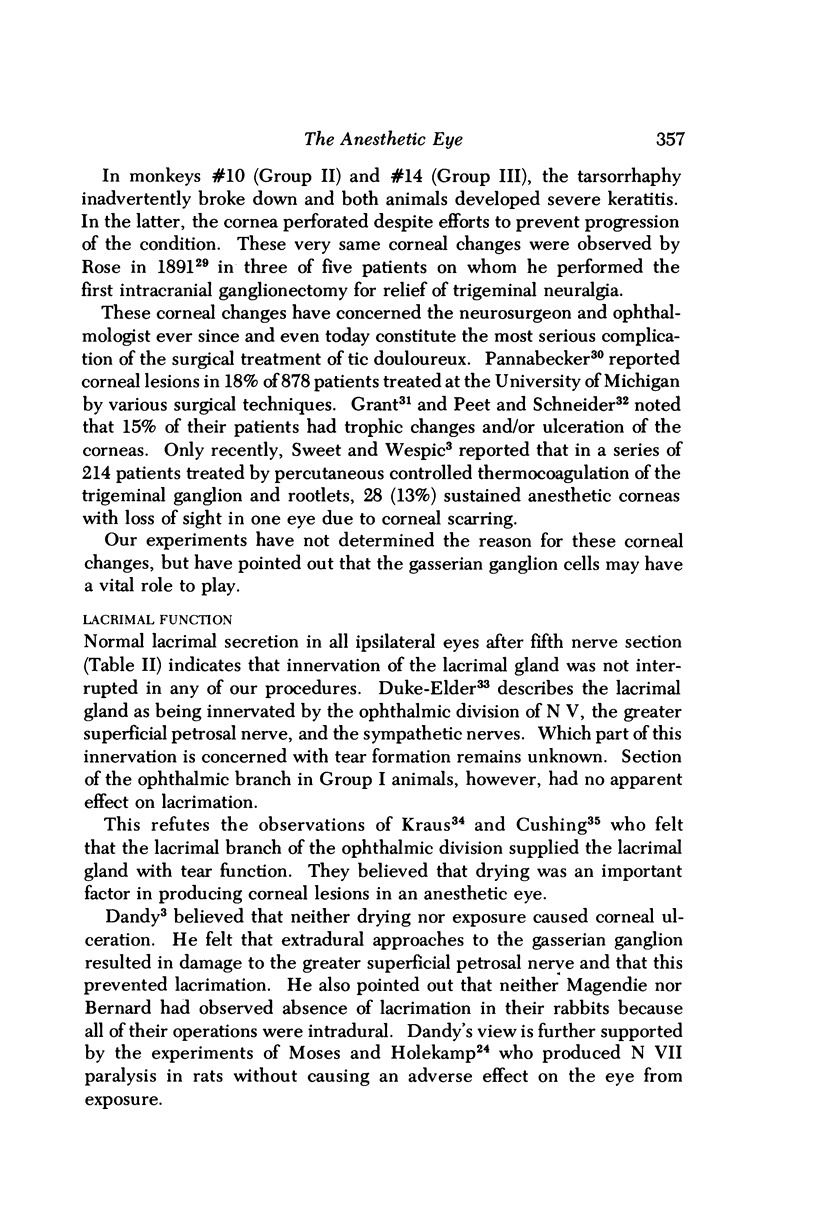
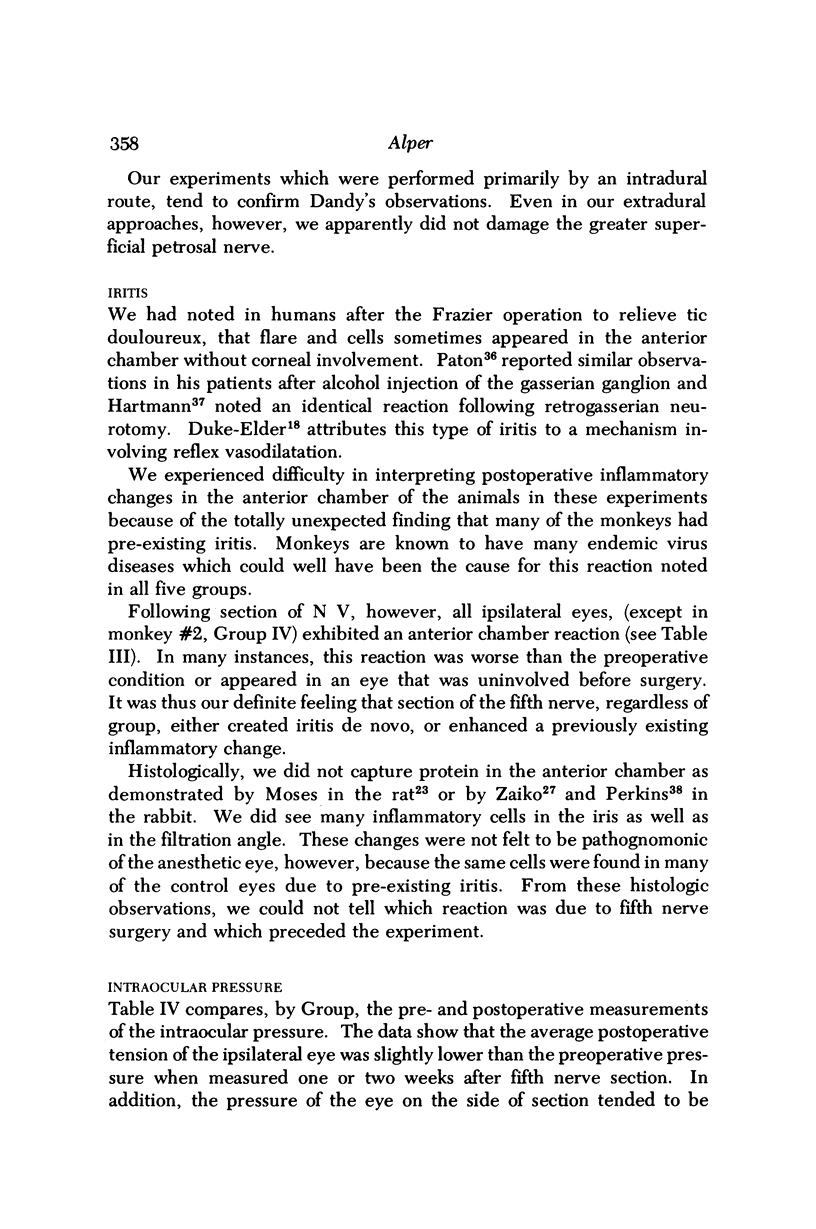
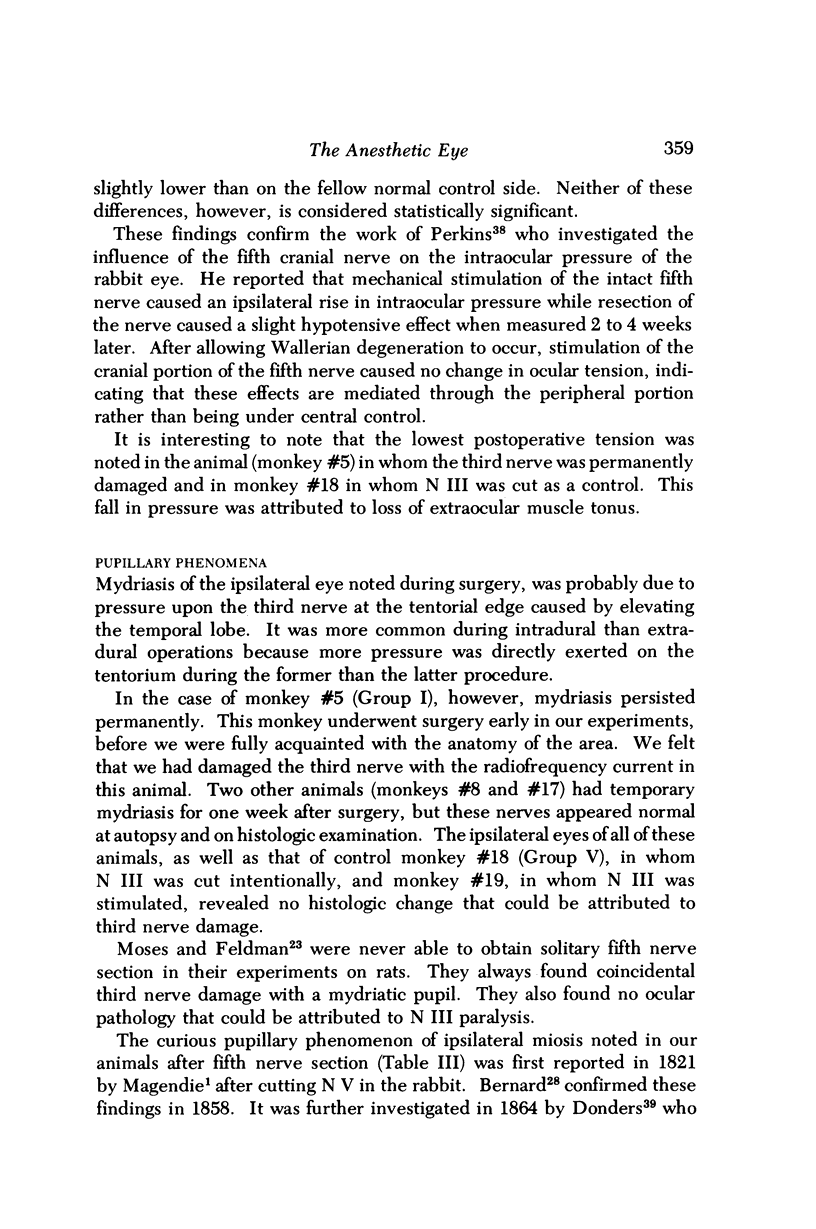
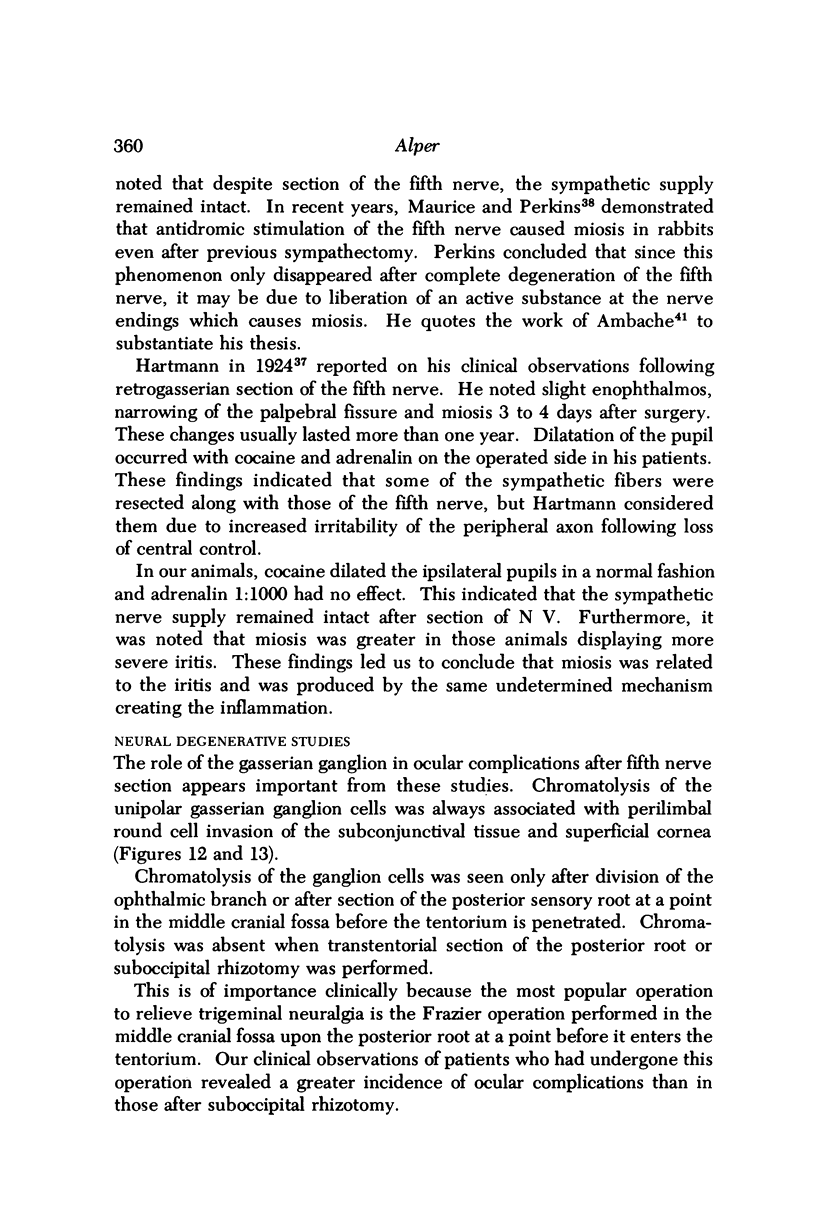
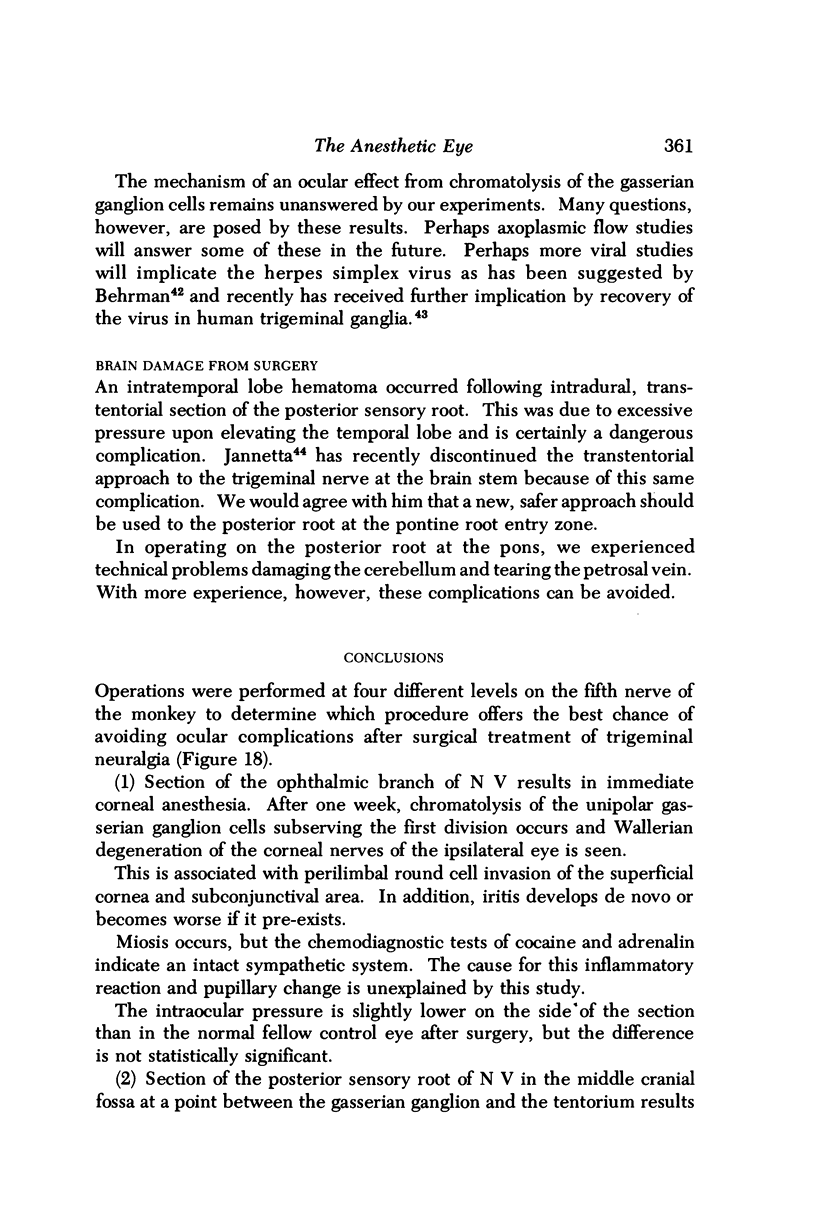
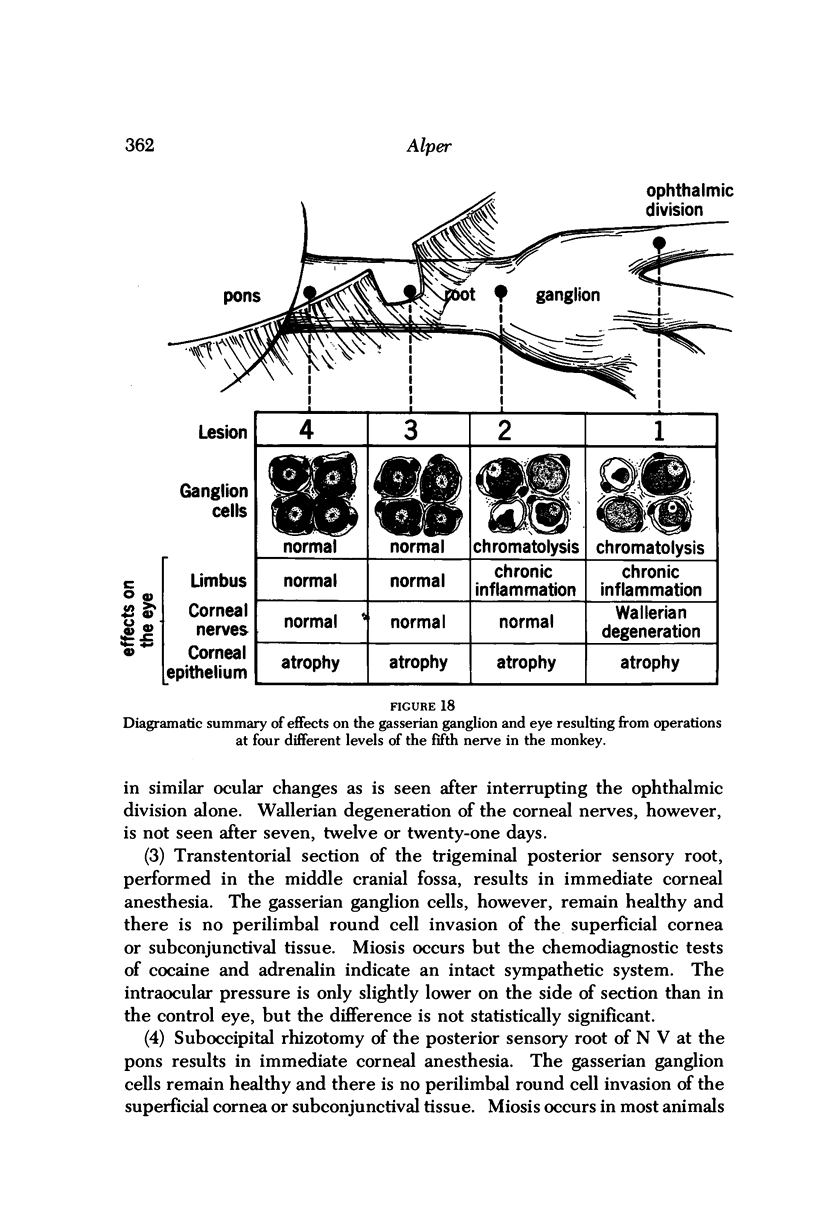
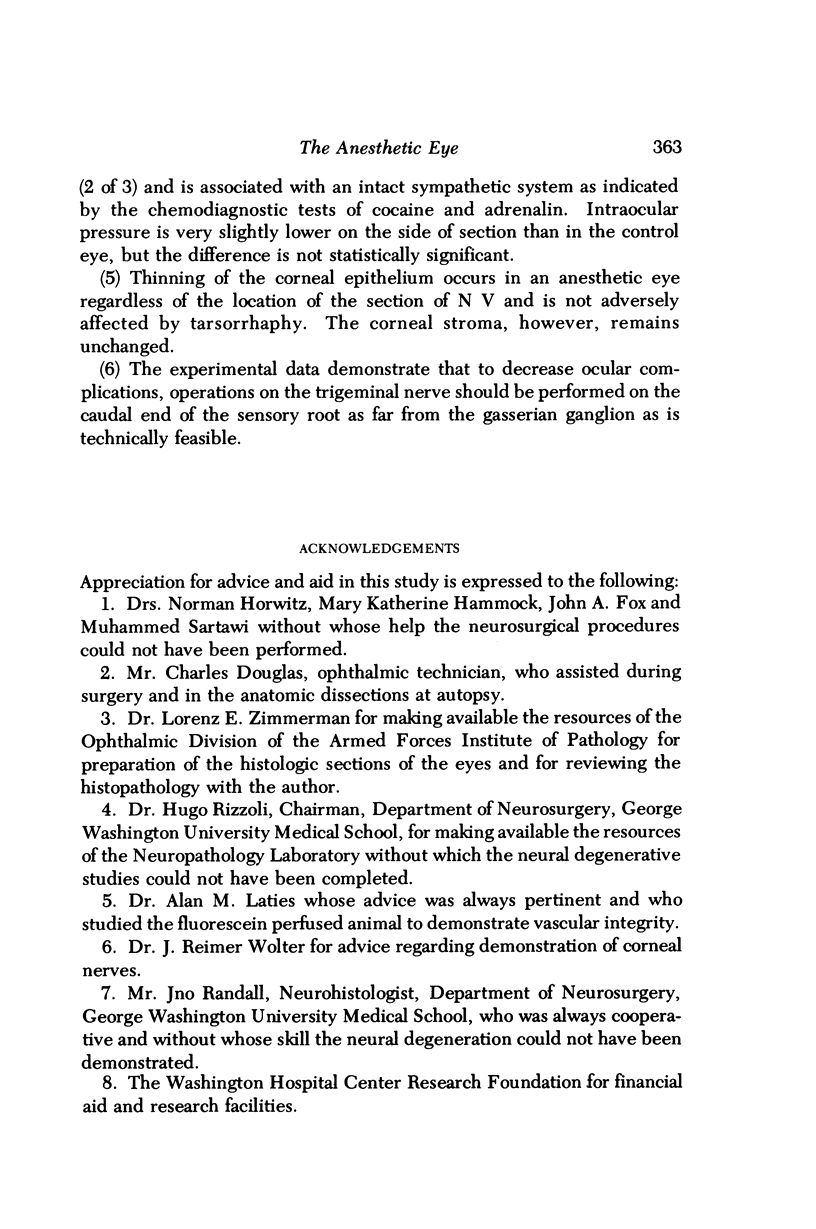


Images in this article
Selected References
These references are in PubMed. This may not be the complete list of references from this article.
- AMBACHE N. Trigeminomimetic action of iris extracts in rabbits. J Physiol. 1956 May 28;132(2):49–50P. [PubMed] [Google Scholar]
- BEHRMAN S., KNIGHT G. Herpes simplex associated with trigeminal neuralgia. Neurology. 1954 Jul;4(7):525–530. doi: 10.1212/wnl.4.7.525. [DOI] [PubMed] [Google Scholar]
- BOBERG-ANS J. On the corneal sensitivity. Acta Ophthalmol (Copenh) 1956;34(3):149–162. doi: 10.1111/j.1755-3768.1956.tb03346.x. [DOI] [PubMed] [Google Scholar]
- Baringer J. R., Swoveland P. Recovery of herpes-simplex virus from human trigeminal ganglions. N Engl J Med. 1973 Mar 29;288(13):648–650. doi: 10.1056/NEJM197303292881303. [DOI] [PubMed] [Google Scholar]
- Emmons W. F., Rhoton A. L., Jr Subdivision of the trigeminal sensory root. Experimental study in the monkey. J Neurosurg. 1971 Nov;35(5):585–591. doi: 10.3171/jns.1971.35.5.0585. [DOI] [PubMed] [Google Scholar]
- Grant F. C. RESULTS IN THE OPERATIVE TREATMENT OF MAJOR TRIGEMINAL NEURALGIA. Ann Surg. 1938 Jan;107(1):14–19. doi: 10.1097/00000658-193801000-00002. [DOI] [PMC free article] [PubMed] [Google Scholar]
- Grayson M. C., Laties A. M. Ocular localization of sodium fluorescein. Effects of administration in rabbit and monkey. Arch Ophthalmol. 1971 May;85(5):600–passim. doi: 10.1001/archopht.1971.00990050602014. [DOI] [PubMed] [Google Scholar]
- Jannetta P. J. Letter: Complications from microsurgical treatment of tic douloureux. J Neurosurg. 1974 May;40(5):675–675. [PubMed] [Google Scholar]
- Jannetta P. J., Rand R. W. Transtentorial retrogasserian rhizotomy in trigeminal neuralgia by microneurosurgical technique. Bull Los Angeles Neurol Soc. 1966 Jul;31(3):93–99. [PubMed] [Google Scholar]
- KERR F. W. THE DIVISIONAL ORGANIZATION OF AFFERENT FIBRES OF THE TRIGEMINAL NERVE. Brain. 1963 Dec;86:721–732. doi: 10.1093/brain/86.4.721. [DOI] [PubMed] [Google Scholar]
- Lende R. A., Poulos D. A. Functional localization in the trigeminal ganglion in the monkey. J Neurosurg. 1970 Mar;32(3):336–343. doi: 10.3171/jns.1970.32.3.0336. [DOI] [PubMed] [Google Scholar]
- MAURICE D. M. Constriction of the pupil in the rabbit by antidromic stimulation of the trigeminal nerve. J Physiol. 1954 Feb 26;123(2):45–6P. [PubMed] [Google Scholar]
- MCCUTCHEON M. Chemotaxis and locomotion of leukocytes. Ann N Y Acad Sci. 1955 Mar 24;59(5):941–944. doi: 10.1111/j.1749-6632.1955.tb45992.x. [DOI] [PubMed] [Google Scholar]
- Moses H. L. Comparative fine structure of the trigeminal ganglia, including human autopsy studies. J Neurosurg. 1967 Jan;26(1 Suppl):112–126. doi: 10.3171/jns.1967.26.1part2.0112. [DOI] [PubMed] [Google Scholar]
- Moses R. A., Feldman M. F. Ocular lesion following fifth-nerve injury in rats. Am J Ophthalmol. 1969 Dec;68(6):1082–1088. doi: 10.1016/0002-9394(69)93451-5. [DOI] [PubMed] [Google Scholar]
- Moses R. A., Holekamp T. L. Evidence against mediation of ocular lesion by exposure, histamine, or serotonin following fifth nerve injury in rats. Am J Ophthalmol. 1971 Feb;71(2):574–577. doi: 10.1016/0002-9394(71)90134-6. [DOI] [PubMed] [Google Scholar]
- PEET M. M., SCHNEIDER R. C. Trigeminal neuralgia; a review of six hundred and eighty-nine cases with a follow-up study of sixty five per cent of the group. J Neurosurg. 1952 Jul;9(4):367–377. doi: 10.3171/jns.1952.9.4.0367. [DOI] [PubMed] [Google Scholar]
- PERKINS E. S. Influence of the fifth cranial nerve on the intra-ocular pressure of the rabbit eye. Br J Ophthalmol. 1957 May;41(5):257–300. doi: 10.1136/bjo.41.5.257. [DOI] [PMC free article] [PubMed] [Google Scholar]
- Paton L. THE TRIGEMINAL AND ITS OCULAR LESIONS. Br J Ophthalmol. 1926 Jun;10(6):305–342. doi: 10.1136/bjo.10.6.305. [DOI] [PMC free article] [PubMed] [Google Scholar]
- Pelletier V. A., Poulos D. A., Lende R. A. Functional localization in the trigeminal root. J Neurosurg. 1974 Apr;40(4):504–513. doi: 10.3171/jns.1974.40.4.0504. [DOI] [PubMed] [Google Scholar]
- RODGER F. C. Source and nature of nerve fibers in cat cornea. AMA Arch Neurol Psychiatry. 1953 Aug;70(2):206–223. doi: 10.1001/archneurpsyc.1953.02320320072006. [DOI] [PubMed] [Google Scholar]
- WEDDELL G., ZANDER E. A critical evaluation of methods used to demonstrate tissue neural elements, illustrated by reference to the cornea. J Anat. 1950 Apr;84(2):168–195. [PMC free article] [PubMed] [Google Scholar]
- ZAIKO N. N. Eksperimental'no-morfologicheskie dannye of razvitii neirodistroficheskogo (neiroparaliticheskogo) keratita. Izv Akad Nauk SSSR Biol. 1954 Mar-Apr;2:99–110. [PubMed] [Google Scholar]
- ZANDER E., WEDDELL G. Observations on the innervation of the cornea. J Anat. 1951 Jan;85(1):68–99. [PMC free article] [PubMed] [Google Scholar]
- ZANDER E., WEDDELL G. Reaction of corneal nerve fibers to injury. Br J Ophthalmol. 1951 Feb;35(2):61–88. doi: 10.1136/bjo.35.2.61. [DOI] [PMC free article] [PubMed] [Google Scholar]

















